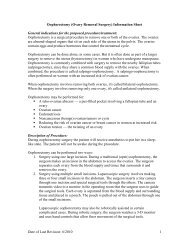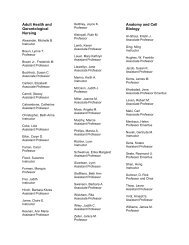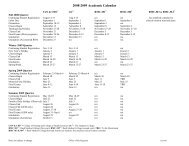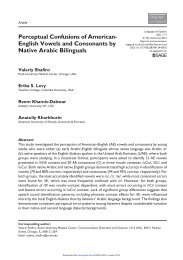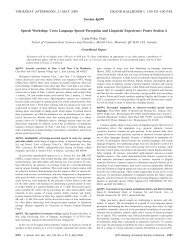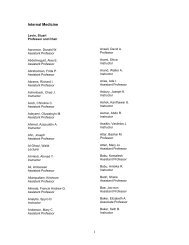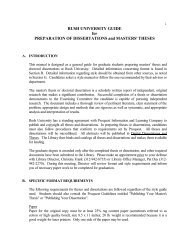Effects of Age and Hearing Loss on the ... - Rush University
Effects of Age and Hearing Loss on the ... - Rush University
Effects of Age and Hearing Loss on the ... - Rush University
Create successful ePaper yourself
Turn your PDF publications into a flip-book with our unique Google optimized e-Paper software.
1<br />
Copyright © Lippincott Williams & Wilkins. Unauthorized reproducti<strong>on</strong> <str<strong>on</strong>g>of</str<strong>on</strong>g> this article is prohibited.<br />
<br />
<str<strong>on</strong>g>Effects</str<strong>on</strong>g> <str<strong>on</strong>g>of</str<strong>on</strong>g> <str<strong>on</strong>g>Age</str<strong>on</strong>g> <str<strong>on</strong>g>and</str<strong>on</strong>g> <str<strong>on</strong>g>Hearing</str<strong>on</strong>g> <str<strong>on</strong>g>Loss</str<strong>on</strong>g> <strong>on</strong> <strong>the</strong> Relati<strong>on</strong>ship<br />
Between Discriminati<strong>on</strong> <str<strong>on</strong>g>of</str<strong>on</strong>g> Stochastic Frequency<br />
Modulati<strong>on</strong> <str<strong>on</strong>g>and</str<strong>on</strong>g> Speech Percepti<strong>on</strong><br />
Stanley Sheft, 1 Valeriy Shafiro, 1 Christian Lorenzi, 2 Rachel McMullen, 1 <str<strong>on</strong>g>and</str<strong>on</strong>g> Caitlin Farrell 1<br />
Objective: The frequency modulati<strong>on</strong> (FM) <str<strong>on</strong>g>of</str<strong>on</strong>g> speech can c<strong>on</strong>vey linguistic<br />
informati<strong>on</strong> <str<strong>on</strong>g>and</str<strong>on</strong>g> also enhance speech-stream coherence <str<strong>on</strong>g>and</str<strong>on</strong>g><br />
segmentati<strong>on</strong>. The purpose <str<strong>on</strong>g>of</str<strong>on</strong>g> <strong>the</strong> present study was to use a clinically<br />
oriented approach to examine <strong>the</strong> effects <str<strong>on</strong>g>of</str<strong>on</strong>g> age <str<strong>on</strong>g>and</str<strong>on</strong>g> hearing loss <strong>on</strong> <strong>the</strong><br />
ability to discriminate between stochastic patterns <str<strong>on</strong>g>of</str<strong>on</strong>g> low-rate FM <str<strong>on</strong>g>and</str<strong>on</strong>g><br />
determine whe<strong>the</strong>r difficulties in speech percepti<strong>on</strong> experienced by older<br />
listeners relate to a deficit in this ability.<br />
Design: Data were collected from 18 normal-hearing young adults, <str<strong>on</strong>g>and</str<strong>on</strong>g><br />
18 participants who were at least 60 years old, nine <str<strong>on</strong>g>of</str<strong>on</strong>g> whom had normal<br />
hearing <str<strong>on</strong>g>and</str<strong>on</strong>g> <strong>the</strong> remaining nine who had a mild-to-moderate sensorineural<br />
hearing loss. Using stochastic frequency modulators derived<br />
from 5-Hz low-pass noise applied to a 1-kHz carrier, discriminati<strong>on</strong><br />
thresholds were measured in terms <str<strong>on</strong>g>of</str<strong>on</strong>g> frequency excursi<strong>on</strong> (ΔF) both in<br />
quiet <str<strong>on</strong>g>and</str<strong>on</strong>g> with a speech-babble masker present, stimulus durati<strong>on</strong>, <str<strong>on</strong>g>and</str<strong>on</strong>g><br />
signal-to-noise ratio (SNR FM<br />
) in <strong>the</strong> presence <str<strong>on</strong>g>of</str<strong>on</strong>g> a speech-babble masker.<br />
Speech-percepti<strong>on</strong> ability was evaluated using Quick Speech-in-Noise<br />
(QuickSIN) sentences in four-talker babble.<br />
Results: Results showed a significant effect <str<strong>on</strong>g>of</str<strong>on</strong>g> age but not <str<strong>on</strong>g>of</str<strong>on</strong>g> hearing<br />
loss am<strong>on</strong>g <strong>the</strong> older listeners, for FM discriminati<strong>on</strong> c<strong>on</strong>diti<strong>on</strong>s with<br />
masking present (ΔF <str<strong>on</strong>g>and</str<strong>on</strong>g> SNR FM<br />
). The effect <str<strong>on</strong>g>of</str<strong>on</strong>g> age was not significant<br />
for <strong>the</strong> FM measures based <strong>on</strong> stimulus durati<strong>on</strong>. ΔF <str<strong>on</strong>g>and</str<strong>on</strong>g> SNR FM<br />
were<br />
also <strong>the</strong> two c<strong>on</strong>diti<strong>on</strong>s for which performance was significantly correlated<br />
with listener age when c<strong>on</strong>trolling for effect <str<strong>on</strong>g>of</str<strong>on</strong>g> hearing loss as<br />
measured by pure-t<strong>on</strong>e average. With respect to speech-in-noise ability,<br />
results from <strong>the</strong> SNR FM<br />
c<strong>on</strong>diti<strong>on</strong> were significantly correlated with<br />
QuickSIN performance.<br />
C<strong>on</strong>clusi<strong>on</strong>s: Results indicate that aging is associated with reduced<br />
ability to discriminate moderate-durati<strong>on</strong> patterns <str<strong>on</strong>g>of</str<strong>on</strong>g> low-rate stochastic<br />
FM. Fur<strong>the</strong>rmore, <strong>the</strong> relati<strong>on</strong>ship between QuickSIN performance <str<strong>on</strong>g>and</str<strong>on</strong>g><br />
<strong>the</strong> SNR FM<br />
thresholds suggests that <strong>the</strong> difficulty experienced by older<br />
listeners with speech-in-noise processing may, in part, relate to diminished<br />
ability to process slower fine-structure modulati<strong>on</strong> at low sensati<strong>on</strong><br />
levels. Results thus suggest that clinical c<strong>on</strong>siderati<strong>on</strong> <str<strong>on</strong>g>of</str<strong>on</strong>g> stochastic<br />
FM discriminati<strong>on</strong> measures may <str<strong>on</strong>g>of</str<strong>on</strong>g>fer a fuller picture <str<strong>on</strong>g>of</str<strong>on</strong>g> auditory-processing<br />
abilities.<br />
(Ear & <str<strong>on</strong>g>Hearing</str<strong>on</strong>g> 2012;00:0–0)<br />
INTRODUCTION<br />
Older listeners <str<strong>on</strong>g>of</str<strong>on</strong>g>ten experience difficulty in underst<str<strong>on</strong>g>and</str<strong>on</strong>g>ing<br />
speech, especially in adverse listening envir<strong>on</strong>ments (e.g.,<br />
Plomp & Mimpen 1979; CHABA 1988; Dubno et al. 2008).<br />
Although peripheral hearing loss has been shown to be a dominant<br />
factor c<strong>on</strong>tributing to this difficulty (van Rooij & Plomp<br />
1990; Humes & Christophers<strong>on</strong> 1991), <strong>the</strong> extent <str<strong>on</strong>g>of</str<strong>on</strong>g> <strong>the</strong> speechprocessing<br />
deficits can exceed expectati<strong>on</strong>s based <strong>on</strong> hearing<br />
thresholds al<strong>on</strong>e (for a review, see Pichora-Fuller & Souza<br />
1<br />
Department <str<strong>on</strong>g>of</str<strong>on</strong>g> Communicati<strong>on</strong> Disorders & Sciences, <strong>Rush</strong> <strong>University</strong><br />
Medical Center, Chicago, Illinois; <str<strong>on</strong>g>and</str<strong>on</strong>g> 2 Département d’Etudes Cognitives<br />
(Equipe Auditi<strong>on</strong>), École Normale Supérieure, Paris, France.<br />
2003). Aspects <str<strong>on</strong>g>of</str<strong>on</strong>g> auditory temporal processing by older listeners<br />
have been evaluated in different attempts to account for <strong>the</strong><br />
discrepancy. For example, deficits associated with listener age<br />
have been reported for measures <str<strong>on</strong>g>of</str<strong>on</strong>g> gap detecti<strong>on</strong> (Strouse et<br />
al. 1998; Phillips et al. 2000; Snell et al. 2002; Helfer & Vargo<br />
2009), detecti<strong>on</strong> <str<strong>on</strong>g>of</str<strong>on</strong>g> amplitude <str<strong>on</strong>g>and</str<strong>on</strong>g> frequency modulati<strong>on</strong> (He<br />
et al. 2007, 2008), forward masking (Gifford et al. 2007), discriminati<strong>on</strong><br />
<str<strong>on</strong>g>of</str<strong>on</strong>g> interaural time <str<strong>on</strong>g>and</str<strong>on</strong>g> phase differences (Divenyi &<br />
Haupt 1997; Grose & Mamo 2010; Hopkins & Moore 2011),<br />
gap, voice-<strong>on</strong>set-time, <str<strong>on</strong>g>and</str<strong>on</strong>g> durati<strong>on</strong> discriminati<strong>on</strong> (Gord<strong>on</strong>-<br />
Salant & Fitzgibb<strong>on</strong>s 1993, 1999; Fitzgibb<strong>on</strong>s & Gord<strong>on</strong>-Salant<br />
1995; Strouse et al. 1998; Tremblay et al. 2003), <str<strong>on</strong>g>and</str<strong>on</strong>g> discriminati<strong>on</strong><br />
<str<strong>on</strong>g>of</str<strong>on</strong>g> temporal order <str<strong>on</strong>g>and</str<strong>on</strong>g> rhythm (Trainor & Trehub 1989;<br />
Humes & Christophers<strong>on</strong> 1991; Gord<strong>on</strong>-Salant & Fitzgibb<strong>on</strong>s<br />
1999; Fitzgibb<strong>on</strong>s et al. 2006). Despite age-related deficits<br />
in measures <str<strong>on</strong>g>of</str<strong>on</strong>g> temporal processing <str<strong>on</strong>g>and</str<strong>on</strong>g> speech percepti<strong>on</strong> in<br />
studies that measured both, a str<strong>on</strong>g relati<strong>on</strong>ship between <strong>the</strong><br />
two has been obtained in <strong>on</strong>ly some studies (Gord<strong>on</strong>-Salant &<br />
Fitzgibb<strong>on</strong>s 1993; Snell et al. 2002; Gifford et al. 2007; Helfer<br />
& Vargo 2009) but not in o<strong>the</strong>rs (van Rooij & Plomp 1990;<br />
Humes & Christophers<strong>on</strong> 1991; Divenyi & Haupt 1997; Strouse<br />
et al. 1998; Gord<strong>on</strong>-Salant & Fitzgibb<strong>on</strong>s 1999; Phillips et al.<br />
2000; Grose et al. 2009). This c<strong>on</strong>trast am<strong>on</strong>g findings has led<br />
to speculati<strong>on</strong> that <strong>the</strong> effect <str<strong>on</strong>g>of</str<strong>on</strong>g> age <strong>on</strong> <strong>the</strong> relati<strong>on</strong>ship between<br />
temporal processing <str<strong>on</strong>g>and</str<strong>on</strong>g> speech percepti<strong>on</strong> is most apparent in<br />
situati<strong>on</strong>s involving complexity in terms <str<strong>on</strong>g>of</str<strong>on</strong>g> stimuli or auditory<br />
tasks (Gord<strong>on</strong>-Salant & Fitzgibb<strong>on</strong>s 1999; Pichora-Fuller &<br />
Souza 2003).<br />
Once processed through <strong>the</strong> frequency-selective channels<br />
<str<strong>on</strong>g>of</str<strong>on</strong>g> <strong>the</strong> auditory system, <strong>the</strong> complexity <str<strong>on</strong>g>of</str<strong>on</strong>g> speech is represented<br />
by changes in <strong>the</strong> short-term amplitude <str<strong>on</strong>g>and</str<strong>on</strong>g> phase spectra<br />
(Flanagan & Golden 1966), or in o<strong>the</strong>r words, in terms <str<strong>on</strong>g>of</str<strong>on</strong>g> fluctuati<strong>on</strong><br />
<str<strong>on</strong>g>of</str<strong>on</strong>g> <strong>the</strong> temporal envelope <str<strong>on</strong>g>and</str<strong>on</strong>g> temporal fine structure<br />
<str<strong>on</strong>g>of</str<strong>on</strong>g> b<str<strong>on</strong>g>and</str<strong>on</strong>g>- limited signals. As variati<strong>on</strong>s in periodicity, dynamic<br />
fine-structure informati<strong>on</strong> can be expressed as frequency modulati<strong>on</strong><br />
(FM) <str<strong>on</strong>g>of</str<strong>on</strong>g> <strong>the</strong> b<str<strong>on</strong>g>and</str<strong>on</strong>g> center frequency. <str<strong>on</strong>g>Effects</str<strong>on</strong>g> <str<strong>on</strong>g>of</str<strong>on</strong>g> listener<br />
age <strong>on</strong> <strong>the</strong> processing <str<strong>on</strong>g>of</str<strong>on</strong>g> speech FM have been obtained in<br />
measures <str<strong>on</strong>g>of</str<strong>on</strong>g> discriminati<strong>on</strong> <str<strong>on</strong>g>of</str<strong>on</strong>g> formant transiti<strong>on</strong>s (Elliott et al.<br />
1989) <str<strong>on</strong>g>and</str<strong>on</strong>g> voicing int<strong>on</strong>ati<strong>on</strong> patterns (Souza et al. 2011), with<br />
age-related deficits in ph<strong>on</strong>etic identificati<strong>on</strong> based <strong>on</strong> dynamic<br />
spectral informati<strong>on</strong> reported by Dorman et al. (1985) <str<strong>on</strong>g>and</str<strong>on</strong>g> Fox<br />
et al. (1992).<br />
The potential involvement <str<strong>on</strong>g>of</str<strong>on</strong>g> FM in speech processing is not<br />
limited to c<strong>on</strong>veying ph<strong>on</strong>etic informati<strong>on</strong>. Speech utterances<br />
are a sequence <str<strong>on</strong>g>of</str<strong>on</strong>g> diverse acoustic events. Speech, however, is<br />
generally perceived as a coherent stream in which events from a<br />
single talker are linked toge<strong>the</strong>r. FM, as represented through <strong>the</strong><br />
pattern <str<strong>on</strong>g>of</str<strong>on</strong>g> int<strong>on</strong>ati<strong>on</strong> <str<strong>on</strong>g>and</str<strong>on</strong>g> formant transiti<strong>on</strong>s, may serve to maintain<br />
this signal coherence (Lackner & Goldstein 1974; Dorman<br />
0196/0202/12/0000-0000/0 • Ear <str<strong>on</strong>g>and</str<strong>on</strong>g> <str<strong>on</strong>g>Hearing</str<strong>on</strong>g> • Copyright © 2012 by Lippincott Williams & Wilkins • Printed in <strong>the</strong> U.S.A.
2 SHEFT ET AL. / EAR & HEARING, VOL. 00, NO. 00, 000–000<br />
et al. 1975). Al<strong>on</strong>g with enhancing coherence, modulati<strong>on</strong> <str<strong>on</strong>g>of</str<strong>on</strong>g><br />
<strong>the</strong> voicing fundamental can aid in <strong>the</strong> necessary segmentati<strong>on</strong><br />
<str<strong>on</strong>g>of</str<strong>on</strong>g> <strong>the</strong> syllable <str<strong>on</strong>g>and</str<strong>on</strong>g> word boundaries <str<strong>on</strong>g>of</str<strong>on</strong>g> <strong>the</strong> <strong>on</strong>going speech<br />
stream (Cutler 1976; Spitzer et al. 2007). This modulati<strong>on</strong> has<br />
been shown to benefit speech intelligibility in <strong>the</strong> presence<br />
<str<strong>on</strong>g>of</str<strong>on</strong>g> competing interference (Laures & Bunt<strong>on</strong> 2003; Binns &<br />
Culling 2007; Miller et al. 2010).<br />
The effect <str<strong>on</strong>g>of</str<strong>on</strong>g> FM rate <strong>on</strong> auditory streaming is low pass with<br />
coherence dropping rapidly with increasing rate >1 to 2 Hz<br />
(Anstis & Saida 1985). Analysis <str<strong>on</strong>g>of</str<strong>on</strong>g> <strong>the</strong> FM spectrum <str<strong>on</strong>g>of</str<strong>on</strong>g> speech<br />
follows a similar low-pass characteristic. Figure 1 shows <strong>the</strong><br />
average modulati<strong>on</strong> spectra <str<strong>on</strong>g>of</str<strong>on</strong>g> <strong>the</strong> fine structure <str<strong>on</strong>g>and</str<strong>on</strong>g> envelope<br />
<str<strong>on</strong>g>of</str<strong>on</strong>g> 300 m<strong>on</strong>osyllabic words spoken by a female talker. * Both<br />
functi<strong>on</strong>s exhibit greatest amplitude at lower modulati<strong>on</strong> rates.<br />
The importance <str<strong>on</strong>g>of</str<strong>on</strong>g> <strong>the</strong> low-rate envelope modulati<strong>on</strong> spectrum<br />
<str<strong>on</strong>g>of</str<strong>on</strong>g> speech is well known (Houtgast & Steeneken 1985). Though<br />
<strong>the</strong> similarity between <strong>the</strong> fine-structure <str<strong>on</strong>g>and</str<strong>on</strong>g> envelope modulati<strong>on</strong><br />
spectra <str<strong>on</strong>g>of</str<strong>on</strong>g> speech in <strong>the</strong> present analysis is anticipated<br />
because <str<strong>on</strong>g>of</str<strong>on</strong>g> correlati<strong>on</strong> between <strong>the</strong> two temporal modulati<strong>on</strong>s<br />
for b<str<strong>on</strong>g>and</str<strong>on</strong>g>-limited stimuli (Papoulis 1983), <strong>the</strong> analysis highlights<br />
<strong>the</strong> potential importance <str<strong>on</strong>g>of</str<strong>on</strong>g> low-rate speech FM.<br />
Sheft <str<strong>on</strong>g>and</str<strong>on</strong>g> Lorenzi (2008) showed that <strong>the</strong> regi<strong>on</strong> <str<strong>on</strong>g>of</str<strong>on</strong>g> best<br />
FM discriminability coincides with <strong>the</strong> low-pass characteristic<br />
<str<strong>on</strong>g>of</str<strong>on</strong>g> speech FM, allowing for significant c<strong>on</strong>tributi<strong>on</strong> to speech<br />
percepti<strong>on</strong>. C<strong>on</strong>diti<strong>on</strong>s evaluated <strong>the</strong> ability <str<strong>on</strong>g>of</str<strong>on</strong>g> normal-hearing<br />
(NH) listeners to discriminate am<strong>on</strong>g stochastic patterns <str<strong>on</strong>g>of</str<strong>on</strong>g> FM<br />
generated by frequency modulating pure-t<strong>on</strong>e carriers with r<str<strong>on</strong>g>and</str<strong>on</strong>g>om<br />
samples <str<strong>on</strong>g>of</str<strong>on</strong>g> low-pass noise. For all values <str<strong>on</strong>g>of</str<strong>on</strong>g> <strong>the</strong> maximum<br />
Fig. 1. Average modulati<strong>on</strong> spectra <str<strong>on</strong>g>of</str<strong>on</strong>g> <strong>the</strong> fine structure (solid line) <str<strong>on</strong>g>and</str<strong>on</strong>g><br />
envelope (dashed line) <str<strong>on</strong>g>of</str<strong>on</strong>g> 300 m<strong>on</strong>osyllabic words spoken by a female<br />
talker. Functi<strong>on</strong>s were derived by passing stimuli through a compressivedynamic<br />
gammachirp filterbank, extracting <strong>the</strong> amplitude <str<strong>on</strong>g>and</str<strong>on</strong>g> frequency<br />
modulati<strong>on</strong> for each channel, <str<strong>on</strong>g>and</str<strong>on</strong>g> <strong>the</strong>n separately averaging <strong>the</strong> two across<br />
channels <str<strong>on</strong>g>and</str<strong>on</strong>g> speech tokens.<br />
*The functi<strong>on</strong>s shown in Figure 1 were derived by first passing <strong>the</strong> stimuli<br />
through a compressive-dynamic gammachirp filterbank simulating peripheral<br />
auditory filtering (Irino & Patters<strong>on</strong> 2006). The fine-structure <str<strong>on</strong>g>and</str<strong>on</strong>g> envelope<br />
modulati<strong>on</strong>s <str<strong>on</strong>g>of</str<strong>on</strong>g> each channel were separately derived. The FM functi<strong>on</strong><br />
was <strong>the</strong> temporal variati<strong>on</strong> from mean value <str<strong>on</strong>g>of</str<strong>on</strong>g> <strong>the</strong> time derivative <str<strong>on</strong>g>of</str<strong>on</strong>g> <strong>the</strong><br />
unwrapped instantaneous phase, <str<strong>on</strong>g>and</str<strong>on</strong>g> <strong>the</strong> envelope functi<strong>on</strong> was <strong>the</strong> magnitude<br />
<str<strong>on</strong>g>of</str<strong>on</strong>g> <strong>the</strong> analytic signal (see Sheft et al. 2008 for additi<strong>on</strong>al details). Last,<br />
<strong>the</strong> two modulati<strong>on</strong> functi<strong>on</strong>s were separately averaged across channels.<br />
frequency excursi<strong>on</strong> after modulati<strong>on</strong> (∆F), discriminability <str<strong>on</strong>g>of</str<strong>on</strong>g><br />
<strong>the</strong> stochastic FM patterns decreased with increasing average<br />
FM rate. Previous work studying frequency discriminati<strong>on</strong> in<br />
<strong>the</strong> c<strong>on</strong>text <str<strong>on</strong>g>of</str<strong>on</strong>g> speech percepti<strong>on</strong> has used frequency glides.<br />
Results indicated a performance decrement with increasing<br />
glide excursi<strong>on</strong> bey<strong>on</strong>d a critical b<str<strong>on</strong>g>and</str<strong>on</strong>g>width (Madden & Fire<br />
1997; Thyer & Mahar 2006). In studies <str<strong>on</strong>g>of</str<strong>on</strong>g> auditory streaming,<br />
coherence is shown to drop with increasing frequency span<br />
between sequential elements (e.g., Bregman 1990). In c<strong>on</strong>trast<br />
to both sets <str<strong>on</strong>g>of</str<strong>on</strong>g> findings, Sheft <str<strong>on</strong>g>and</str<strong>on</strong>g> Lorenzi (2008) found that<br />
performance improved with increasing ∆F. Their work showed<br />
that for <strong>the</strong> stochastically modulated stimuli, increasing ∆F<br />
enhances pattern distincti<strong>on</strong>, which in turn aids discriminati<strong>on</strong>.<br />
This is not <strong>the</strong> case for discriminati<strong>on</strong> <str<strong>on</strong>g>of</str<strong>on</strong>g> m<strong>on</strong>ot<strong>on</strong>ic frequency<br />
glides. Fur<strong>the</strong>rmore, pattern distincti<strong>on</strong> would not be expected<br />
to be a factor that enhances sequence coherence per se. However,<br />
discriminati<strong>on</strong> based <strong>on</strong> distinctive features <str<strong>on</strong>g>of</str<strong>on</strong>g> a complex<br />
time-varying stimulus is a central aspect <str<strong>on</strong>g>of</str<strong>on</strong>g> speech processing.<br />
This discriminati<strong>on</strong> can help to distinguish ph<strong>on</strong>emic c<strong>on</strong>trasts<br />
<str<strong>on</strong>g>and</str<strong>on</strong>g> guide segmentati<strong>on</strong> <str<strong>on</strong>g>of</str<strong>on</strong>g> <strong>the</strong> speech stream into meaningful<br />
units (e.g., Stevens 2002; Li & Loizou 2008).<br />
To evaluate whe<strong>the</strong>r FM discriminati<strong>on</strong> cues remain effective<br />
in background noise to allow for possible c<strong>on</strong>tributi<strong>on</strong><br />
to speech-in-noise processing, Sheft <str<strong>on</strong>g>and</str<strong>on</strong>g> Lorenzi (2008) also<br />
evaluated performance in a number <str<strong>on</strong>g>of</str<strong>on</strong>g> masking c<strong>on</strong>diti<strong>on</strong>s.<br />
The additi<strong>on</strong> <str<strong>on</strong>g>of</str<strong>on</strong>g> an unmodulated noise masker at a signalto-noise<br />
ratio (SNR) <str<strong>on</strong>g>of</str<strong>on</strong>g> 6 dB had little effect <strong>on</strong> FM-pattern<br />
discriminati<strong>on</strong>. Fur<strong>the</strong>rmore, nei<strong>the</strong>r sinusoidal amplitude<br />
modulati<strong>on</strong> <str<strong>on</strong>g>of</str<strong>on</strong>g> <strong>the</strong> masker at a low rate (4 or 20 Hz) nor reducti<strong>on</strong><br />
<str<strong>on</strong>g>of</str<strong>on</strong>g> <strong>the</strong> SNR to −2 dB significantly altered <strong>the</strong> amount <str<strong>on</strong>g>of</str<strong>on</strong>g><br />
masking. Results thus indicated viability <str<strong>on</strong>g>of</str<strong>on</strong>g> low-rate FM cues<br />
to aid speech percepti<strong>on</strong> in <strong>the</strong> presence <str<strong>on</strong>g>of</str<strong>on</strong>g> modulated maskers,<br />
even at low sensati<strong>on</strong> levels.<br />
The present study directly evaluated <strong>the</strong> relati<strong>on</strong>ship<br />
between <strong>the</strong> ability to discriminate am<strong>on</strong>g stochastic patterns<br />
<str<strong>on</strong>g>of</str<strong>on</strong>g> low-rate FM <str<strong>on</strong>g>and</str<strong>on</strong>g> speech percepti<strong>on</strong> in both NH young adults<br />
<str<strong>on</strong>g>and</str<strong>on</strong>g> older listeners with ei<strong>the</strong>r near-NH thresholds or a mildto-moderate<br />
sensorineural hearing loss. The hypo<strong>the</strong>sis was<br />
that difficulty experienced by older listeners in underst<str<strong>on</strong>g>and</str<strong>on</strong>g>ing<br />
speech against background interference would relate in<br />
significant part to impaired processing <str<strong>on</strong>g>of</str<strong>on</strong>g> FM. Experimental<br />
protocol was clinically oriented. As such, <strong>the</strong> procedure was<br />
not focused <strong>on</strong> determining asymptotic performance levels,<br />
but ra<strong>the</strong>r <strong>on</strong> providing a basis for subsequent development <str<strong>on</strong>g>of</str<strong>on</strong>g><br />
a clinically feasible approach for assessment <str<strong>on</strong>g>of</str<strong>on</strong>g> listener abilities.<br />
For a fuller underst<str<strong>on</strong>g>and</str<strong>on</strong>g>ing <str<strong>on</strong>g>of</str<strong>on</strong>g> <strong>the</strong> auditory processing <str<strong>on</strong>g>of</str<strong>on</strong>g><br />
stochastic FM, discriminati<strong>on</strong> ability was measured in five<br />
separate tasks that estimated thresholds in terms <str<strong>on</strong>g>of</str<strong>on</strong>g> frequency<br />
excursi<strong>on</strong>, stimulus durati<strong>on</strong>, or SNR in <strong>the</strong> presence <str<strong>on</strong>g>of</str<strong>on</strong>g> a<br />
speech-babble masker. For each listener, speech-discriminati<strong>on</strong><br />
ability was measured both in quiet <str<strong>on</strong>g>and</str<strong>on</strong>g> in <strong>the</strong> presence <str<strong>on</strong>g>of</str<strong>on</strong>g> a<br />
speech-babble masker.<br />
Discriminati<strong>on</strong> <str<strong>on</strong>g>of</str<strong>on</strong>g> stochastic FM introduces uncertainty<br />
into <strong>the</strong> procedure through <strong>the</strong> sampling <str<strong>on</strong>g>of</str<strong>on</strong>g> independent noise<br />
modulators. Collins et al. (1994) suggested that by incorporating<br />
aspects <str<strong>on</strong>g>of</str<strong>on</strong>g> natural speech, use <str<strong>on</strong>g>of</str<strong>on</strong>g> stimulus uncertainty in<br />
psychoacoustic paradigms increases predictive power regarding<br />
listener performance in speech tasks. Much <str<strong>on</strong>g>of</str<strong>on</strong>g> <strong>the</strong> previous<br />
work involving stimulus uncertainty has been c<strong>on</strong>ducted in<br />
<strong>the</strong> c<strong>on</strong>text <str<strong>on</strong>g>of</str<strong>on</strong>g> informati<strong>on</strong>al masking (for a review, see Kidd<br />
et al. 2008). With frequency patterns, informati<strong>on</strong>al-masking<br />
Copyright © Lippincott Williams & Wilkins. Unauthorized reproducti<strong>on</strong> <str<strong>on</strong>g>of</str<strong>on</strong>g> this article is prohibited.
SHEFT ET AL. / EAR & HEARING, VOL. 00, NO. 00, 000–000 3<br />
studies have generally manipulated a single target element<br />
<str<strong>on</strong>g>of</str<strong>on</strong>g> <strong>the</strong> pattern. For speech percepti<strong>on</strong>, intelligibility relies not<br />
<strong>on</strong> <strong>the</strong> processing <str<strong>on</strong>g>of</str<strong>on</strong>g> a single target element, but ra<strong>the</strong>r <strong>on</strong> <strong>the</strong><br />
entire temporal pattern (Remez et al. 1994). In c<strong>on</strong>trast with<br />
<strong>the</strong> earlier work involving frequency uncertainty, <strong>the</strong> present<br />
study evaluated <strong>the</strong> ability to discriminate a change in <strong>the</strong> whole<br />
pattern to bring <strong>the</strong> psychoacoustic procedure closer to a central<br />
aspect <str<strong>on</strong>g>of</str<strong>on</strong>g> speech processing.<br />
PARTICIPANTS AND METHODS<br />
Participants<br />
Three groups <str<strong>on</strong>g>of</str<strong>on</strong>g> listeners participated in <strong>the</strong> study. The first<br />
c<strong>on</strong>sisted <str<strong>on</strong>g>of</str<strong>on</strong>g> 18 young adults (16 women; age range: 22–33<br />
years; mean: 23.7 years) who had normal audiometric thresholds<br />
(≤ 15 dB HL re: American Nati<strong>on</strong>al St<str<strong>on</strong>g>and</str<strong>on</strong>g>ards Institute<br />
[ANSI] 2004) for <strong>the</strong> octave frequencies between 0.25 to 8.0<br />
kHz. The sec<strong>on</strong>d <str<strong>on</strong>g>and</str<strong>on</strong>g> third groups c<strong>on</strong>sisted <str<strong>on</strong>g>of</str<strong>on</strong>g> nine older listeners<br />
each, with <strong>the</strong> groups distinguished by pure-t<strong>on</strong>e average<br />
(PTA) audiometric thresholds at 0.5, 1.0, <str<strong>on</strong>g>and</str<strong>on</strong>g> 2.0 kHz as ei<strong>the</strong>r<br />
NH or hearing impaired (HI). The nine participants in <strong>the</strong> sec<strong>on</strong>d<br />
group (five women; age range: 61–72 years; mean: 65.3<br />
years) had a PTA <str<strong>on</strong>g>of</str<strong>on</strong>g> 20 dB HL or less in each ear. For <strong>the</strong> third<br />
group, <strong>the</strong> nine listeners (four women; age range: 61–84 years;<br />
mean: 70.6 years) had a mild-to-moderate sloping hearing loss<br />
c<strong>on</strong>firmed as sensorineural by b<strong>on</strong>e c<strong>on</strong>ducti<strong>on</strong> thresholds <str<strong>on</strong>g>and</str<strong>on</strong>g><br />
tympanometry. <str<strong>on</strong>g>Hearing</str<strong>on</strong>g> loss was symmetric with PTAs varying<br />
by ≤ 12 dB between ears (for seven <str<strong>on</strong>g>of</str<strong>on</strong>g> <strong>the</strong> listeners, <strong>the</strong> difference<br />
was ≤ 5 dB) <str<strong>on</strong>g>and</str<strong>on</strong>g> binaural PTAs ranging from 22 to 53 dB<br />
HL. Average group audiograms are shown in Figure 2. Despite<br />
labeling <str<strong>on</strong>g>of</str<strong>on</strong>g> <strong>the</strong> participants <str<strong>on</strong>g>of</str<strong>on</strong>g> sec<strong>on</strong>d group as older NH listeners<br />
based <strong>on</strong> PTA, all but two <str<strong>on</strong>g>of</str<strong>on</strong>g> <strong>the</strong>m exhibited at least a mild<br />
hearing loss at 4 <str<strong>on</strong>g>and</str<strong>on</strong>g> 8 kHz. All study participants achieved a<br />
score <str<strong>on</strong>g>of</str<strong>on</strong>g> 25 or greater <strong>on</strong> <strong>the</strong> Mini Mental Status Examinati<strong>on</strong><br />
(Folstein et al. 1975) <str<strong>on</strong>g>and</str<strong>on</strong>g> spoke English as <strong>the</strong>ir first <str<strong>on</strong>g>and</str<strong>on</strong>g> primary<br />
language.<br />
Psychoacoustic Stimuli <str<strong>on</strong>g>and</str<strong>on</strong>g> Procedure<br />
Five c<strong>on</strong>diti<strong>on</strong>s measured discriminati<strong>on</strong> thresholds between<br />
pairs <str<strong>on</strong>g>of</str<strong>on</strong>g> stimuli that were frequency modulated by low-pass<br />
noise. If n(t) is <strong>the</strong> zero-mean noise modulator with <strong>the</strong> absolute<br />
value <str<strong>on</strong>g>of</str<strong>on</strong>g> peak amplitude scaled to 1.0, <strong>the</strong> general form <str<strong>on</strong>g>of</str<strong>on</strong>g> <strong>the</strong><br />
discrete stimulus is given as follows:<br />
s(t) = sin[2π* f *t + (2π * ΔF/sr) * N(t)]<br />
where t is time, f is carrier frequency, N(t) is <strong>the</strong> cumulative<br />
integral <str<strong>on</strong>g>of</str<strong>on</strong>g> n(t), ΔF is <strong>the</strong> maximum frequency excursi<strong>on</strong><br />
caused by modulati<strong>on</strong>, <str<strong>on</strong>g>and</str<strong>on</strong>g> sr is sampling rate. A c<strong>on</strong>sequence<br />
<str<strong>on</strong>g>of</str<strong>on</strong>g> <strong>the</strong> modulati<strong>on</strong> is that <strong>the</strong> instantaneous frequency <str<strong>on</strong>g>of</str<strong>on</strong>g> <strong>the</strong><br />
stimulus follows <strong>the</strong> amplitude pattern <str<strong>on</strong>g>of</str<strong>on</strong>g> <strong>the</strong> noise modulator.<br />
This is illustrated in <strong>the</strong> top two panels <str<strong>on</strong>g>of</str<strong>on</strong>g> Figure 3 for a<br />
5-Hz low-pass noise modulator <str<strong>on</strong>g>and</str<strong>on</strong>g> 400-Hz ΔF. The b<str<strong>on</strong>g>and</str<strong>on</strong>g>width<br />
<str<strong>on</strong>g>of</str<strong>on</strong>g> <strong>the</strong> noise modulator determines <strong>the</strong> average rate <str<strong>on</strong>g>of</str<strong>on</strong>g><br />
frequency modulati<strong>on</strong> (equal to ~0.78 <str<strong>on</strong>g>of</str<strong>on</strong>g> <strong>the</strong> low-pass cut<str<strong>on</strong>g>of</str<strong>on</strong>g>f<br />
frequency in Hz). † Because <str<strong>on</strong>g>of</str<strong>on</strong>g> <strong>the</strong> stochastic modulati<strong>on</strong>, <strong>the</strong><br />
†With narrowb<str<strong>on</strong>g>and</str<strong>on</strong>g> noise modulators, both fine-structure <str<strong>on</strong>g>and</str<strong>on</strong>g> envelope<br />
periodicities <str<strong>on</strong>g>of</str<strong>on</strong>g> <strong>the</strong> modulator c<strong>on</strong>tribute to <strong>the</strong> average rate <str<strong>on</strong>g>of</str<strong>on</strong>g> FM. The<br />
relati<strong>on</strong>ship between modulator b<str<strong>on</strong>g>and</str<strong>on</strong>g>width <str<strong>on</strong>g>and</str<strong>on</strong>g> average FM rate was determined<br />
empirically by analyzing 5000 stimulus samples at each <str<strong>on</strong>g>of</str<strong>on</strong>g> <strong>the</strong> modulator<br />
b<str<strong>on</strong>g>and</str<strong>on</strong>g>widths used in <strong>the</strong> study by Sheft <str<strong>on</strong>g>and</str<strong>on</strong>g> Lorenzi (2008).<br />
Fig. 2. Average left (L) <str<strong>on</strong>g>and</str<strong>on</strong>g> right (R) ear audiograms for <strong>the</strong> three subject<br />
groups. Error bars are 1 SD <str<strong>on</strong>g>of</str<strong>on</strong>g> <strong>the</strong> mean threshold.<br />
l<strong>on</strong>g-term stimulus spectrum is c<strong>on</strong>tinuous with a b<str<strong>on</strong>g>and</str<strong>on</strong>g>width<br />
that reflects modulator peak amplitude (see Fig. 3, bottom<br />
panel). In all c<strong>on</strong>diti<strong>on</strong>s, modulator b<str<strong>on</strong>g>and</str<strong>on</strong>g>width was fixed<br />
at 5 Hz <str<strong>on</strong>g>and</str<strong>on</strong>g> FM carrier frequency at 1 kHz. Using r<str<strong>on</strong>g>and</str<strong>on</strong>g>om<br />
assignment <str<strong>on</strong>g>of</str<strong>on</strong>g> coefficients in an inverse fast Fourier transform,<br />
noise modulators were digitally generated with 0.25-Hz<br />
frequency resoluti<strong>on</strong>.<br />
All c<strong>on</strong>diti<strong>on</strong>s were intended to measure <strong>the</strong> ability to discriminate<br />
stimuli based <strong>on</strong> differences in <strong>the</strong> temporal pattern<br />
<str<strong>on</strong>g>of</str<strong>on</strong>g> frequency fluctuati<strong>on</strong> about <strong>the</strong> carrier frequency ra<strong>the</strong>r<br />
than variati<strong>on</strong>s in l<strong>on</strong>g-term or peak stimulus characteristics.<br />
To maintain a c<strong>on</strong>stant ΔF, modulator peak amplitude was<br />
kept c<strong>on</strong>stant for all stimuli <str<strong>on</strong>g>of</str<strong>on</strong>g> a given discriminati<strong>on</strong> trial.<br />
The c<strong>on</strong>trasting modulators <str<strong>on</strong>g>of</str<strong>on</strong>g> each discriminati<strong>on</strong> trial were<br />
ei<strong>the</strong>r independent samples drawn from <strong>the</strong> same underlying<br />
noise distributi<strong>on</strong>, or were single r<str<strong>on</strong>g>and</str<strong>on</strong>g>om samples paired with<br />
<strong>the</strong>ir time reversal scaled by −1.0 after cumulative integrati<strong>on</strong>.<br />
In <strong>the</strong> first approach, <strong>the</strong> average l<strong>on</strong>g-term amplitude spectra<br />
are identical across stimuli because <str<strong>on</strong>g>of</str<strong>on</strong>g> <strong>the</strong> comm<strong>on</strong> sampling<br />
distributi<strong>on</strong>. The time reversal <str<strong>on</strong>g>and</str<strong>on</strong>g> sign change <str<strong>on</strong>g>of</str<strong>on</strong>g> <strong>the</strong> sec<strong>on</strong>d<br />
approach leads to a time reversal <str<strong>on</strong>g>of</str<strong>on</strong>g> <strong>the</strong> instantaneous-frequency<br />
functi<strong>on</strong> between <strong>the</strong> c<strong>on</strong>trasting stimuli <str<strong>on</strong>g>of</str<strong>on</strong>g> each trial, with <strong>the</strong><br />
l<strong>on</strong>g-term amplitude spectra <str<strong>on</strong>g>of</str<strong>on</strong>g> <strong>the</strong> stimuli always <strong>the</strong> same.<br />
In <strong>the</strong> sec<strong>on</strong>d approach, however, <strong>the</strong> correlati<strong>on</strong> between <strong>the</strong><br />
instantaneous-frequency functi<strong>on</strong>s <str<strong>on</strong>g>of</str<strong>on</strong>g> a stimulus pair is generally<br />
n<strong>on</strong>zero because <str<strong>on</strong>g>of</str<strong>on</strong>g> <strong>the</strong> modulators not being independent<br />
noise samples. Figure 4 illustrates <strong>the</strong> instantaneous-frequency<br />
functi<strong>on</strong>s <str<strong>on</strong>g>of</str<strong>on</strong>g> a c<strong>on</strong>trasting stimulus pair generated by independent<br />
sampling. The average rate <str<strong>on</strong>g>of</str<strong>on</strong>g> frequency fluctuati<strong>on</strong> (i.e.,<br />
modulator b<str<strong>on</strong>g>and</str<strong>on</strong>g>width) <str<strong>on</strong>g>and</str<strong>on</strong>g> maximum frequency deviati<strong>on</strong> from<br />
<strong>the</strong> carrier frequency (i.e., ΔF) are <strong>the</strong> same for <strong>the</strong> two stimuli<br />
so that discriminati<strong>on</strong> must rely <strong>on</strong>ly <strong>on</strong> <strong>the</strong> temporal pattern <str<strong>on</strong>g>of</str<strong>on</strong>g><br />
frequency deviati<strong>on</strong>.<br />
Copyright © Lippincott Williams & Wilkins. Unauthorized reproducti<strong>on</strong> <str<strong>on</strong>g>of</str<strong>on</strong>g> this article is prohibited.
4 SHEFT ET AL. / EAR & HEARING, VOL. 00, NO. 00, 000–000<br />
Fig. 3. Analysis <str<strong>on</strong>g>of</str<strong>on</strong>g> stochastic FM. Top panel: time wave form <str<strong>on</strong>g>of</str<strong>on</strong>g> a 5-Hz lowpass<br />
noise modulator. Middle panel: instantaneous-frequency functi<strong>on</strong> when<br />
<strong>the</strong> modulator is applied to a 1-kHz pure-t<strong>on</strong>e carrier with ΔF equal to 400<br />
Hz. Bottom panel: l<strong>on</strong>g-term amplitude spectrum <str<strong>on</strong>g>of</str<strong>on</strong>g> <strong>the</strong> modulated stimulus.<br />
The ability to discriminate stochastic FM was measured with a<br />
cued two-interval forced-choice (2IFC) adaptive procedure. Five<br />
hundred millisec<strong>on</strong>ds separated <strong>the</strong> three stimulus presentati<strong>on</strong>s<br />
<str<strong>on</strong>g>of</str<strong>on</strong>g> a trial. On each trial, a r<str<strong>on</strong>g>and</str<strong>on</strong>g>omly selected noise modulator was<br />
used as <strong>the</strong> cue modulator <str<strong>on</strong>g>of</str<strong>on</strong>g> <strong>the</strong> 1-kHz carrier. With r<str<strong>on</strong>g>and</str<strong>on</strong>g>om<br />
selecti<strong>on</strong>, <strong>on</strong>e <str<strong>on</strong>g>of</str<strong>on</strong>g> <strong>the</strong> two observati<strong>on</strong> intervals that followed <strong>the</strong><br />
cue was identical to <strong>the</strong> cue; <strong>the</strong> o<strong>the</strong>r interval was generated with<br />
a c<strong>on</strong>trasting modulator. The listener’s task was to indicate which<br />
observati<strong>on</strong> interval differed from <strong>the</strong> cue with feedback provided<br />
after each trial. Across <strong>the</strong> five c<strong>on</strong>diti<strong>on</strong>s, thresholds were<br />
estimated in terms <str<strong>on</strong>g>of</str<strong>on</strong>g> three independent variables described later.<br />
Using a two-down <strong>on</strong>e-up tracking rule that c<strong>on</strong>verged <strong>on</strong> 70.7%<br />
(Levitt 1971), threshold estimates were based <strong>on</strong> <strong>the</strong> average<br />
<str<strong>on</strong>g>of</str<strong>on</strong>g> <strong>the</strong> last eight <str<strong>on</strong>g>of</str<strong>on</strong>g> <strong>the</strong> required minimum <str<strong>on</strong>g>of</str<strong>on</strong>g> twelve tracking<br />
reversals with run length always at least 40 trials. C<strong>on</strong>cerned<br />
with clinical feasibility <str<strong>on</strong>g>of</str<strong>on</strong>g> <strong>the</strong> psychoacoustic measures, all data<br />
from each listener were collected during a single sessi<strong>on</strong> with <strong>on</strong>e<br />
threshold estimate per c<strong>on</strong>diti<strong>on</strong>. Results thus represent nei<strong>the</strong>r<br />
trained nor asymptotic performance levels. For practice, listeners<br />
initially completed <strong>the</strong> first c<strong>on</strong>diti<strong>on</strong> without scoring; <strong>the</strong>reafter,<br />
each subsequent run was scored. All scored runs began with eight<br />
practice trials. Each run took roughly 5 to 6 min.<br />
There were five FM c<strong>on</strong>diti<strong>on</strong>s with <strong>the</strong> first three using<br />
<strong>the</strong> independent-samples method <str<strong>on</strong>g>of</str<strong>on</strong>g> generating c<strong>on</strong>trasting<br />
modulators, <str<strong>on</strong>g>and</str<strong>on</strong>g> <strong>the</strong> last two using <strong>the</strong> time-reversal method.<br />
The sec<strong>on</strong>d <str<strong>on</strong>g>and</str<strong>on</strong>g> third c<strong>on</strong>diti<strong>on</strong>s used a c<strong>on</strong>tinuous four-talker<br />
speech-babble masker spoken by <strong>on</strong>e male <str<strong>on</strong>g>and</str<strong>on</strong>g> three female<br />
Fig. 4. Schematic illustrati<strong>on</strong> <str<strong>on</strong>g>of</str<strong>on</strong>g> two examples <str<strong>on</strong>g>of</str<strong>on</strong>g> stochastic frequency<br />
modulati<strong>on</strong> in a typical trial showing <strong>the</strong> c<strong>on</strong>trasting instantaneousfrequency<br />
functi<strong>on</strong>s <str<strong>on</strong>g>of</str<strong>on</strong>g> <strong>the</strong> stimuli. With independent noise samples used<br />
as modulators across trials, instantaneous-frequency functi<strong>on</strong>s also varied<br />
across trials.<br />
talkers. The masker was c<strong>on</strong>tinuous in that it began roughly 10 s<br />
before <strong>the</strong> first trial <str<strong>on</strong>g>of</str<strong>on</strong>g> a run <str<strong>on</strong>g>and</str<strong>on</strong>g> remained <strong>on</strong> until feedback was<br />
provided for <strong>the</strong> final trial. The average power spectrum <str<strong>on</strong>g>of</str<strong>on</strong>g> <strong>the</strong><br />
masker is shown in Figure 5. A 2 min sample <str<strong>on</strong>g>of</str<strong>on</strong>g> <strong>the</strong> masker output<br />
over Etymotic ER-3A insert earph<strong>on</strong>es (Etymotic Research,<br />
Elk Grove Village, IL), was recorded through a KEMAR. On<br />
<strong>the</strong> basis <str<strong>on</strong>g>of</str<strong>on</strong>g> Fourier transform coefficients, level was determined<br />
in c<strong>on</strong>secutive 1/3-octave b<str<strong>on</strong>g>and</str<strong>on</strong>g>s. Results are expressed<br />
in dB relative <strong>the</strong> power <str<strong>on</strong>g>of</str<strong>on</strong>g> a 1-kHz pure t<strong>on</strong>e (<strong>the</strong> FM carrier<br />
in all discriminati<strong>on</strong> c<strong>on</strong>diti<strong>on</strong>s), with both <strong>the</strong> masker <str<strong>on</strong>g>and</str<strong>on</strong>g> pure<br />
t<strong>on</strong>e presented separately at 80 dB SPL. For b<str<strong>on</strong>g>and</str<strong>on</strong>g> center frequencies<br />
ranging from roughly 0.6 to 1.6 kHz that approximate<br />
<strong>the</strong> widest frequency excursi<strong>on</strong> <str<strong>on</strong>g>of</str<strong>on</strong>g> stimuli in <strong>the</strong> discriminati<strong>on</strong><br />
c<strong>on</strong>diti<strong>on</strong>s, average b<str<strong>on</strong>g>and</str<strong>on</strong>g> power level varied from −15.3 to −10.3<br />
dB relative <strong>the</strong> FM carrier.<br />
Data were collected from each listener in <strong>the</strong> following order:<br />
1. Delta F. The maximum frequency excursi<strong>on</strong> <str<strong>on</strong>g>of</str<strong>on</strong>g> <strong>the</strong> FM<br />
t<strong>on</strong>es was varied in <strong>the</strong> first c<strong>on</strong>diti<strong>on</strong> so that <strong>the</strong> minimum<br />
ΔF needed to discriminate 500 msec stochastic FM<br />
patterns could be determined. Stimulus level was 80 dB<br />
SPL. In <strong>the</strong> adaptive threshold procedure, ΔF was varied<br />
geometrically. Beginning at 400 Hz, ΔF was initially<br />
changed by a factor <str<strong>on</strong>g>of</str<strong>on</strong>g> 1.46, with factor size reduced to<br />
Copyright © Lippincott Williams & Wilkins. Unauthorized reproducti<strong>on</strong> <str<strong>on</strong>g>of</str<strong>on</strong>g> this article is prohibited.
SHEFT ET AL. / EAR & HEARING, VOL. 00, NO. 00, 000–000 5<br />
Fig. 5. Average power spectrum <str<strong>on</strong>g>of</str<strong>on</strong>g> <strong>the</strong> speech-babble masker recorded<br />
through a KEMAR as a functi<strong>on</strong> <str<strong>on</strong>g>of</str<strong>on</strong>g> <strong>the</strong> center frequency <str<strong>on</strong>g>of</str<strong>on</strong>g> <strong>the</strong> c<strong>on</strong>secutive<br />
1/3-octave b<str<strong>on</strong>g>and</str<strong>on</strong>g>s used in analysis. Levels are expressed in dB relative <strong>the</strong><br />
power <str<strong>on</strong>g>of</str<strong>on</strong>g> a 1-kHz pure-t<strong>on</strong>e with both <strong>the</strong> masker <str<strong>on</strong>g>and</str<strong>on</strong>g> pure t<strong>on</strong>e presented<br />
separately at 80 dB SPL.<br />
1.10 after <strong>the</strong> sec<strong>on</strong>d tracking reversal. With thresholds<br />
in terms <str<strong>on</strong>g>of</str<strong>on</strong>g> frequency excursi<strong>on</strong>, <strong>the</strong> procedure provides<br />
a measure <str<strong>on</strong>g>of</str<strong>on</strong>g> sensitivity in terms <str<strong>on</strong>g>of</str<strong>on</strong>g> <strong>the</strong> magnitude <str<strong>on</strong>g>of</str<strong>on</strong>g> pattern<br />
deviati<strong>on</strong> from <strong>the</strong> carrier frequency.<br />
2. Masked delta F. The sec<strong>on</strong>d c<strong>on</strong>diti<strong>on</strong> repeated c<strong>on</strong>diti<strong>on</strong><br />
1 in <strong>the</strong> presence <str<strong>on</strong>g>of</str<strong>on</strong>g> <strong>the</strong> c<strong>on</strong>tinuous speech-babble<br />
masker. A high SNR <str<strong>on</strong>g>of</str<strong>on</strong>g> 16 dB was used to minimize energetic<br />
masking so effects might relate more directly to factors<br />
such as attenti<strong>on</strong> <str<strong>on</strong>g>and</str<strong>on</strong>g> distracti<strong>on</strong>.<br />
3. SNR FM<br />
. With <strong>the</strong> c<strong>on</strong>tinuous speech-babble masker fixed<br />
at 80 dB SPL <str<strong>on</strong>g>and</str<strong>on</strong>g> ΔF fixed at 400 Hz, <strong>the</strong> level <str<strong>on</strong>g>of</str<strong>on</strong>g> <strong>the</strong><br />
FM t<strong>on</strong>es was varied in <strong>the</strong> third c<strong>on</strong>diti<strong>on</strong> to determine<br />
<strong>the</strong> SNR needed to discriminate patterns <str<strong>on</strong>g>of</str<strong>on</strong>g> frequency<br />
fluctuati<strong>on</strong>. Initial tracking step size was 6 dB, which was<br />
reduced to 2 dB after <strong>the</strong> sec<strong>on</strong>d reversal. The fixed ΔF <str<strong>on</strong>g>of</str<strong>on</strong>g><br />
400 Hz extends well bey<strong>on</strong>d <strong>the</strong> b<str<strong>on</strong>g>and</str<strong>on</strong>g>width <str<strong>on</strong>g>of</str<strong>on</strong>g> <strong>the</strong> auditory<br />
filter tuned to <strong>the</strong> 1-kHz carrier frequency, allowing for<br />
significant involvement <str<strong>on</strong>g>of</str<strong>on</strong>g> cross-channel processing <str<strong>on</strong>g>of</str<strong>on</strong>g><br />
<strong>the</strong> stochastic modulati<strong>on</strong>. The results obtained with this<br />
metric allow for evaluati<strong>on</strong> <str<strong>on</strong>g>of</str<strong>on</strong>g> discriminati<strong>on</strong> ability at<br />
low sensati<strong>on</strong> levels, a characteristic <str<strong>on</strong>g>of</str<strong>on</strong>g> many adverse<br />
listening envir<strong>on</strong>ments in which speech processing is<br />
difficult.<br />
The fourth <str<strong>on</strong>g>and</str<strong>on</strong>g> fifth c<strong>on</strong>diti<strong>on</strong>s measured discriminati<strong>on</strong><br />
thresholds without masking in terms <str<strong>on</strong>g>of</str<strong>on</strong>g> stimulus durati<strong>on</strong>. With<br />
short durati<strong>on</strong>s, listeners do not follow <strong>the</strong> frequency fluctuati<strong>on</strong>s<br />
<str<strong>on</strong>g>of</str<strong>on</strong>g> <strong>the</strong> stimuli, but ra<strong>the</strong>r perceive stimuli globally in terms<br />
<str<strong>on</strong>g>of</str<strong>on</strong>g> overall characteristics such as timbre. Support for involvement<br />
<str<strong>on</strong>g>of</str<strong>on</strong>g> durati<strong>on</strong>-specific cues comes from <strong>the</strong> c<strong>on</strong>diti<strong>on</strong>s discussed<br />
by Sheft <str<strong>on</strong>g>and</str<strong>on</strong>g> Lorenzi (2008) in which carrier frequency<br />
was r<str<strong>on</strong>g>and</str<strong>on</strong>g>omized between <strong>the</strong> cue <str<strong>on</strong>g>and</str<strong>on</strong>g> observati<strong>on</strong> intervals <str<strong>on</strong>g>of</str<strong>on</strong>g> a<br />
trial. Results showed little effect <str<strong>on</strong>g>of</str<strong>on</strong>g> r<str<strong>on</strong>g>and</str<strong>on</strong>g>omizati<strong>on</strong> with a 500<br />
msec stimulus durati<strong>on</strong>, but near-chance performance if <strong>the</strong><br />
durati<strong>on</strong> was
6 SHEFT ET AL. / EAR & HEARING, VOL. 00, NO. 00, 000–000<br />
<str<strong>on</strong>g>of</str<strong>on</strong>g> <strong>the</strong> same four-talker babble used in <strong>the</strong> psychoacoustic c<strong>on</strong>diti<strong>on</strong>s.<br />
Across <strong>the</strong> six sentences <str<strong>on</strong>g>of</str<strong>on</strong>g> each list, <strong>the</strong> SNR decreases in<br />
5 dB steps from 25 to 0 dB. On <strong>the</strong> basis <str<strong>on</strong>g>of</str<strong>on</strong>g> <strong>the</strong> number <str<strong>on</strong>g>of</str<strong>on</strong>g> key<br />
words correctly repeated, <strong>the</strong> results are c<strong>on</strong>verted to <strong>the</strong> metric<br />
SNR <str<strong>on</strong>g>Loss</str<strong>on</strong>g>, <strong>the</strong> estimated SNR needed for 50% correct relative to<br />
<strong>the</strong> performance <str<strong>on</strong>g>of</str<strong>on</strong>g> NH listeners. For each subject, results were<br />
obtained <strong>on</strong> four QuickSIN sentence lists to allow for estimati<strong>on</strong><br />
<str<strong>on</strong>g>of</str<strong>on</strong>g> <strong>the</strong> intelligibility-functi<strong>on</strong> slope at P(c) <str<strong>on</strong>g>of</str<strong>on</strong>g> 0.5 al<strong>on</strong>g with measurement<br />
<str<strong>on</strong>g>of</str<strong>on</strong>g> <strong>the</strong> SNR <str<strong>on</strong>g>Loss</str<strong>on</strong>g>. To ensure that subjects understood <strong>the</strong><br />
task, a separate practice list was administered before scored testing.<br />
Speech testing was c<strong>on</strong>ducted in a double-walled soundpro<str<strong>on</strong>g>of</str<strong>on</strong>g><br />
booth using Etymotic ER-3A insert earph<strong>on</strong>es.<br />
RESULTS<br />
Stochastic FM<br />
In data figures, box plots indicating performance <str<strong>on</strong>g>of</str<strong>on</strong>g> <strong>the</strong><br />
younger listeners are shown al<strong>on</strong>g with individual results from<br />
both <strong>the</strong> older NH <str<strong>on</strong>g>and</str<strong>on</strong>g> HI participants. Threshold measures <str<strong>on</strong>g>of</str<strong>on</strong>g><br />
delta F are shown in Figure 6. With or without <strong>the</strong> speech-babble<br />
masker present (Fig. 6 right <str<strong>on</strong>g>and</str<strong>on</strong>g> left figure panels, respectively),<br />
thresholds from both NH <str<strong>on</strong>g>and</str<strong>on</strong>g> HI older listeners were generally<br />
equal to or greater than <strong>the</strong> median thresholds <str<strong>on</strong>g>of</str<strong>on</strong>g> <strong>the</strong> young NH<br />
subjects. The <strong>on</strong>e excepti<strong>on</strong> to this trend, a 63-year-old subject<br />
whose thresholds in both tasks were <strong>the</strong> lowest am<strong>on</strong>g all participants,<br />
had PTAs in both ears <str<strong>on</strong>g>of</str<strong>on</strong>g>
SHEFT ET AL. / EAR & HEARING, VOL. 00, NO. 00, 000–000 7<br />
indicating that some listeners remained unable to use shortdurati<strong>on</strong><br />
discriminati<strong>on</strong> cues.<br />
For both <strong>the</strong> durati<strong>on</strong> descending <str<strong>on</strong>g>and</str<strong>on</strong>g> durati<strong>on</strong> ascending<br />
c<strong>on</strong>diti<strong>on</strong>s, ANOVAs <strong>on</strong> <strong>the</strong> log-transformed durati<strong>on</strong> thresholds<br />
showed that <strong>the</strong> effect <str<strong>on</strong>g>of</str<strong>on</strong>g> subject group was not significant.<br />
To evaluate <strong>the</strong> effect <str<strong>on</strong>g>of</str<strong>on</strong>g> procedure in <strong>the</strong> durati<strong>on</strong> c<strong>on</strong>diti<strong>on</strong>s,<br />
a mixed-design ANOVA was c<strong>on</strong>ducted, which compared<br />
within-subject durati<strong>on</strong> descending to durati<strong>on</strong> ascending results<br />
with <strong>the</strong> between-subjects factor age category (young or older).<br />
The effect <str<strong>on</strong>g>of</str<strong>on</strong>g> procedure was significant (F (1,26)<br />
= 71.544,<br />
p < 0.001) whereas age category was not, c<strong>on</strong>firming <strong>the</strong> overall<br />
trend for lower thresholds in <strong>the</strong> durati<strong>on</strong> ascending c<strong>on</strong>diti<strong>on</strong>.<br />
Fig. 7. For <strong>the</strong> three subject groups, thresholds from <strong>the</strong> signal-to-noise ratio<br />
c<strong>on</strong>diti<strong>on</strong>. The median threshold from <strong>the</strong> younger listeners is indicated by<br />
<strong>the</strong> box plot to <strong>the</strong> left; <strong>the</strong> upper <str<strong>on</strong>g>and</str<strong>on</strong>g> lower box edges indicate <strong>the</strong> 25th <str<strong>on</strong>g>and</str<strong>on</strong>g><br />
75th percentiles, with error bars showing <strong>the</strong> 10th <str<strong>on</strong>g>and</str<strong>on</strong>g> 90th percentiles. The<br />
circles <str<strong>on</strong>g>and</str<strong>on</strong>g> triangles show individual results from <strong>the</strong> older normal-hearing<br />
<str<strong>on</strong>g>and</str<strong>on</strong>g> hearing-impaired subjects, respectively. SNR, signal-to-noise ratio.<br />
durati<strong>on</strong>, <strong>the</strong> durati<strong>on</strong> ascending c<strong>on</strong>diti<strong>on</strong> was run to obtain a<br />
better estimate <str<strong>on</strong>g>of</str<strong>on</strong>g> performance as a functi<strong>on</strong> <str<strong>on</strong>g>of</str<strong>on</strong>g> durati<strong>on</strong> with<br />
results shown in <strong>the</strong> right panel <str<strong>on</strong>g>of</str<strong>on</strong>g> Figure 8. Between <strong>the</strong> durati<strong>on</strong><br />
descending <str<strong>on</strong>g>and</str<strong>on</strong>g> durati<strong>on</strong> ascending c<strong>on</strong>diti<strong>on</strong>s, <strong>the</strong> geometric<br />
mean <str<strong>on</strong>g>of</str<strong>on</strong>g> thresholds dropped by a factor <str<strong>on</strong>g>of</str<strong>on</strong>g> 4.5, 4.6, <str<strong>on</strong>g>and</str<strong>on</strong>g><br />
6.3 for <strong>the</strong> younger, older NH, <str<strong>on</strong>g>and</str<strong>on</strong>g> older HI subject groups,<br />
respectively. This result is c<strong>on</strong>sistent with better use <str<strong>on</strong>g>of</str<strong>on</strong>g> <strong>the</strong><br />
short-durati<strong>on</strong> global cues in <strong>the</strong> durati<strong>on</strong> ascending c<strong>on</strong>diti<strong>on</strong>.<br />
However, <strong>the</strong> threshold range across listeners in all subject<br />
groups remained large in <strong>the</strong> durati<strong>on</strong> ascending c<strong>on</strong>diti<strong>on</strong>,<br />
Speech Measures<br />
Average NU-6 word discriminati<strong>on</strong> in quiet, based <strong>on</strong> <strong>the</strong><br />
between-ear average for <strong>the</strong> individual listeners, was close to<br />
ceiling being 98%, 93%, <str<strong>on</strong>g>and</str<strong>on</strong>g> 94% correct for <strong>the</strong> young, older<br />
NH, <str<strong>on</strong>g>and</str<strong>on</strong>g> older HI subject groups, respectively. In all but four<br />
cases, <strong>the</strong> between-ear difference in performance was four percentage<br />
points or less. Summary results from QuickSIN testing<br />
with <strong>the</strong> speech-babble masker are displayed in Figure 9. The<br />
lower panel <str<strong>on</strong>g>of</str<strong>on</strong>g> <strong>the</strong> figure shows <strong>the</strong> mean SNR <str<strong>on</strong>g>Loss</str<strong>on</strong>g> for <strong>the</strong> three<br />
subject groups with mean thresholds <str<strong>on</strong>g>of</str<strong>on</strong>g> −0.5, 0.83, <str<strong>on</strong>g>and</str<strong>on</strong>g> 4.75 dB<br />
for <strong>the</strong> young, older NH, <str<strong>on</strong>g>and</str<strong>on</strong>g> older HI listeners, respectively.<br />
An ANOVA showed that <strong>the</strong> effect <str<strong>on</strong>g>of</str<strong>on</strong>g> subject group was significant<br />
for SNR <str<strong>on</strong>g>Loss</str<strong>on</strong>g> (F (2,33)<br />
= 12.947, p < 0.001), with Tukey’s<br />
HSD post hoc comparis<strong>on</strong>s indicating significant differences<br />
<strong>on</strong>ly between <strong>the</strong> performance <str<strong>on</strong>g>of</str<strong>on</strong>g> <strong>the</strong> older HI listeners <str<strong>on</strong>g>and</str<strong>on</strong>g> <strong>the</strong><br />
younger (p < 0.001) <str<strong>on</strong>g>and</str<strong>on</strong>g> older NH (p = 0.007) subject groups.<br />
The top panel <str<strong>on</strong>g>of</str<strong>on</strong>g> Figure 9 shows <strong>the</strong> mean intelligibility<br />
functi<strong>on</strong>s for <strong>the</strong> three subject groups transformed into rati<strong>on</strong>alized<br />
arcsine units (Studebaker 1985). In additi<strong>on</strong> to indicating<br />
<strong>the</strong> between-group change in SNR needed to achieve a specific<br />
performance level, <strong>the</strong> slope <str<strong>on</strong>g>of</str<strong>on</strong>g> <strong>the</strong> intelligibility functi<strong>on</strong> was<br />
shallowest for <strong>the</strong> older HI listeners. Following <strong>the</strong> approach<br />
<str<strong>on</strong>g>of</str<strong>on</strong>g> Wils<strong>on</strong> et al. (2007), a best-fit third-degree polynomial was<br />
used to estimate <strong>the</strong> functi<strong>on</strong> slope at <strong>the</strong> 50% point <str<strong>on</strong>g>of</str<strong>on</strong>g> <strong>the</strong><br />
individual subject data. With performance always >50% correct<br />
at all SNRs, results from three young NH listeners were<br />
Fig. 8. For <strong>the</strong> three subject groups, thresholds from <strong>the</strong><br />
durati<strong>on</strong> descending <str<strong>on</strong>g>and</str<strong>on</strong>g> durati<strong>on</strong> ascending c<strong>on</strong>diti<strong>on</strong>s<br />
in <strong>the</strong> left <str<strong>on</strong>g>and</str<strong>on</strong>g> right panels, respectively. The box plot<br />
at <strong>the</strong> left in each panel shows <strong>the</strong> median threshold<br />
from <strong>the</strong> younger listeners; <strong>the</strong> upper <str<strong>on</strong>g>and</str<strong>on</strong>g> lower box<br />
edges indicate <strong>the</strong> 25th <str<strong>on</strong>g>and</str<strong>on</strong>g> 75th percentiles with error<br />
bars showing <strong>the</strong> 10th <str<strong>on</strong>g>and</str<strong>on</strong>g> 90th percentiles. Individual<br />
results from <strong>the</strong> older normal-hearing <str<strong>on</strong>g>and</str<strong>on</strong>g> hearingimpaired<br />
subjects are displayed as circles <str<strong>on</strong>g>and</str<strong>on</strong>g> triangles,<br />
respectively.<br />
Copyright © Lippincott Williams & Wilkins. Unauthorized reproducti<strong>on</strong> <str<strong>on</strong>g>of</str<strong>on</strong>g> this article is prohibited.
8 SHEFT ET AL. / EAR & HEARING, VOL. 00, NO. 00, 000–000<br />
group was significant (F (2,30)<br />
= 7.533, p = 0.002) with Tukey’s<br />
HSD post hoc comparis<strong>on</strong>s indicating significant differences<br />
<strong>on</strong>ly between <strong>the</strong> performance <str<strong>on</strong>g>of</str<strong>on</strong>g> <strong>the</strong> older HI listeners <str<strong>on</strong>g>and</str<strong>on</strong>g> <strong>the</strong><br />
younger (p = 0.004) <str<strong>on</strong>g>and</str<strong>on</strong>g> older NH (p = 0.006) subject groups.<br />
Fig. 9. Quick Speech-in-Noise test results. Top panel: for <strong>the</strong> three subject<br />
groups, mean speech-in-noise intelligibility transformed into rau as a functi<strong>on</strong><br />
<str<strong>on</strong>g>of</str<strong>on</strong>g> signal-to-noise ratio. The functi<strong>on</strong> fits are illustrative <str<strong>on</strong>g>and</str<strong>on</strong>g> do not represent<br />
<strong>the</strong> third-degree polynomials used to fit individual subject data (see<br />
text for details). Al<strong>on</strong>g <strong>the</strong> right axis, data points indicate <strong>the</strong> mean intelligibility-functi<strong>on</strong><br />
slope at <strong>the</strong> 50% point <str<strong>on</strong>g>of</str<strong>on</strong>g> <strong>the</strong> individual subject data in units<br />
<str<strong>on</strong>g>of</str<strong>on</strong>g> percent change in performance per dB <str<strong>on</strong>g>of</str<strong>on</strong>g> signal-to-noise ratio. Bottom<br />
panel: mean SNR <str<strong>on</strong>g>Loss</str<strong>on</strong>g> for <strong>the</strong> three subject groups with error bars representing<br />
1 SD. rau, rati<strong>on</strong>alized arcsine units. SNR, signal-to-noise ratio.<br />
excluded from this analysis. Estimated mean functi<strong>on</strong> slopes<br />
at <strong>the</strong> 50% point are shown al<strong>on</strong>g <strong>the</strong> right axis <str<strong>on</strong>g>of</str<strong>on</strong>g> <strong>the</strong> upper<br />
panel <str<strong>on</strong>g>of</str<strong>on</strong>g> Figure 9 in units <str<strong>on</strong>g>of</str<strong>on</strong>g> percent change in performance<br />
per dB <str<strong>on</strong>g>of</str<strong>on</strong>g> SNR. Mean functi<strong>on</strong> slopes were nearly identical at<br />
approximately 14% per dB change in SNR for <strong>the</strong> young <str<strong>on</strong>g>and</str<strong>on</strong>g><br />
older NH listeners, with <strong>the</strong> mean slope slightly
SHEFT ET AL. / EAR & HEARING, VOL. 00, NO. 00, 000–000 9<br />
The effect <str<strong>on</strong>g>of</str<strong>on</strong>g> hearing loss was fur<strong>the</strong>r evaluated using a betweensubjects<br />
analysis <str<strong>on</strong>g>of</str<strong>on</strong>g> covariance with age category (young <str<strong>on</strong>g>and</str<strong>on</strong>g><br />
old) as a fixed factor <str<strong>on</strong>g>and</str<strong>on</strong>g> PTA as a covariate. In line with <strong>the</strong><br />
correlati<strong>on</strong> results, <strong>the</strong> effect <str<strong>on</strong>g>of</str<strong>on</strong>g> covariate PTA was significant<br />
<strong>on</strong>ly for QuickSIN SNR <str<strong>on</strong>g>Loss</str<strong>on</strong>g> (F (1,33)<br />
= 39.526, p < 0.001), <str<strong>on</strong>g>and</str<strong>on</strong>g><br />
<strong>the</strong> effect <str<strong>on</strong>g>of</str<strong>on</strong>g> age category was significant <strong>on</strong>ly for <strong>the</strong> SNR FM<br />
(F (1,33)<br />
= 12.137, p = 0.001) <str<strong>on</strong>g>and</str<strong>on</strong>g> masked delta F (F (1,33)<br />
= 12.803,<br />
p = 0.001) measures. Results thus indicate that <strong>the</strong> two measures<br />
<str<strong>on</strong>g>of</str<strong>on</strong>g> FM processing in <strong>the</strong> presence <str<strong>on</strong>g>of</str<strong>on</strong>g> interference provide<br />
informati<strong>on</strong> regarding <strong>the</strong> effect <str<strong>on</strong>g>of</str<strong>on</strong>g> aging that is not obtained<br />
with <strong>the</strong> o<strong>the</strong>r procedures.<br />
In Table 1, a significant correlati<strong>on</strong> between <strong>the</strong> SNR FM<br />
thresholds<br />
<str<strong>on</strong>g>and</str<strong>on</strong>g> QuickSIN performance (r = 0.489, p = 0.013) suggests<br />
that an FM-processing deficit may c<strong>on</strong>tribute to difficulty with<br />
speech-in-noise intelligibility. The absence <str<strong>on</strong>g>of</str<strong>on</strong>g> a significant relati<strong>on</strong>ship<br />
between <strong>the</strong> QuickSIN SNR <str<strong>on</strong>g>Loss</str<strong>on</strong>g> <str<strong>on</strong>g>and</str<strong>on</strong>g> ei<strong>the</strong>r delta F or<br />
masked delta F indicates a limitati<strong>on</strong> <strong>on</strong> <strong>the</strong> relati<strong>on</strong>ship between<br />
FM <str<strong>on</strong>g>and</str<strong>on</strong>g> speech-in-noise processing. For <strong>the</strong> metrics used, <strong>the</strong><br />
relati<strong>on</strong>ship was most apparent with <strong>the</strong> low sensati<strong>on</strong> levels <str<strong>on</strong>g>of</str<strong>on</strong>g><br />
<strong>the</strong> modulated stimuli in <strong>the</strong> SNR FM<br />
c<strong>on</strong>diti<strong>on</strong>.<br />
DISCUSSION<br />
The ability to discriminate stochastic FM was investigated<br />
for both young <str<strong>on</strong>g>and</str<strong>on</strong>g> older listeners with thresholds measured<br />
in terms <str<strong>on</strong>g>of</str<strong>on</strong>g> peak frequency excursi<strong>on</strong> or ΔF, stimulus durati<strong>on</strong>,<br />
<str<strong>on</strong>g>and</str<strong>on</strong>g> SNR in <strong>the</strong> presence <str<strong>on</strong>g>of</str<strong>on</strong>g> a four-talker speech-babble<br />
masker. Experimental protocol was clinically oriented <str<strong>on</strong>g>and</str<strong>on</strong>g> did<br />
not attempt to estimate asymptotic performance levels. Results<br />
showed a significant effect <str<strong>on</strong>g>of</str<strong>on</strong>g> age, but not <str<strong>on</strong>g>of</str<strong>on</strong>g> hearing loss am<strong>on</strong>g<br />
<strong>the</strong> older listeners, in <strong>the</strong> masked delta F <str<strong>on</strong>g>and</str<strong>on</strong>g> SNR FM<br />
c<strong>on</strong>diti<strong>on</strong>s,<br />
<strong>the</strong> <strong>on</strong>ly two psychoacoustic c<strong>on</strong>diti<strong>on</strong>s that used a speechbabble<br />
masker. These were also <strong>the</strong> two c<strong>on</strong>diti<strong>on</strong>s for which<br />
performance was significantly correlated with listener age when<br />
c<strong>on</strong>trolling for effect <str<strong>on</strong>g>of</str<strong>on</strong>g> PTA. These comm<strong>on</strong> effects in <strong>the</strong> two<br />
masking c<strong>on</strong>diti<strong>on</strong>s were obtained despite <strong>the</strong> 16 dB difference<br />
in masker level. Previous studies have shown that thresholds for<br />
detecti<strong>on</strong> <str<strong>on</strong>g>of</str<strong>on</strong>g> periodic low-rate FM are elevated for both elderly<br />
<str<strong>on</strong>g>and</str<strong>on</strong>g> HI listeners (Moore & Skrodzka 2002; Buss et al. 2004; He<br />
et al. 2007; Strelcyk & Dau 2009). Though FM detecti<strong>on</strong> is requisite,<br />
FM-pattern discriminati<strong>on</strong> must also underlie any robust<br />
c<strong>on</strong>tributi<strong>on</strong> to speech processing. Souza et al. (2011) recently<br />
reported that for subjects with normal to near-NH thresholds,<br />
discriminati<strong>on</strong> <str<strong>on</strong>g>of</str<strong>on</strong>g> voicing int<strong>on</strong>ati<strong>on</strong> patterns, represented as a<br />
m<strong>on</strong>ot<strong>on</strong>ic frequency glide over 620 msec, was poorer am<strong>on</strong>g<br />
older (mean age 70 years) than younger (mean age 24 years)<br />
listeners. The fluctuati<strong>on</strong> <str<strong>on</strong>g>of</str<strong>on</strong>g> <strong>the</strong> stochastic FM <str<strong>on</strong>g>of</str<strong>on</strong>g> <strong>the</strong> present<br />
work is n<strong>on</strong>m<strong>on</strong>ot<strong>on</strong>ic, extending <strong>the</strong> finding <str<strong>on</strong>g>of</str<strong>on</strong>g> an effect <str<strong>on</strong>g>of</str<strong>on</strong>g> age<br />
to more complex pattern discriminati<strong>on</strong>.<br />
The correlati<strong>on</strong> analysis indicated a significant relati<strong>on</strong>ship<br />
between 4-kHz thresholds <str<strong>on</strong>g>and</str<strong>on</strong>g> both <strong>the</strong> masked delta F <str<strong>on</strong>g>and</str<strong>on</strong>g><br />
SNR FM<br />
results, even when c<strong>on</strong>trolling for <strong>the</strong> effect <str<strong>on</strong>g>of</str<strong>on</strong>g> PTA.<br />
With a 1-kHz FM carrier frequency <str<strong>on</strong>g>and</str<strong>on</strong>g> ΔF at most 400 Hz, <strong>the</strong><br />
correlati<strong>on</strong> between <strong>the</strong> FM measures <str<strong>on</strong>g>and</str<strong>on</strong>g> auditory thresholds<br />
at 4 kHz was not expected. The result is c<strong>on</strong>sistent with <strong>the</strong> findings<br />
<str<strong>on</strong>g>of</str<strong>on</strong>g> Lorenzi et al. (2009) <str<strong>on</strong>g>and</str<strong>on</strong>g> Strelcyk <str<strong>on</strong>g>and</str<strong>on</strong>g> Dau (2009), that<br />
when accompanied by a high-frequency hearing loss, processing<br />
<str<strong>on</strong>g>of</str<strong>on</strong>g> temporal fine structure can be impaired in a lower-frequency<br />
regi<strong>on</strong> <str<strong>on</strong>g>of</str<strong>on</strong>g> NH sensitivity. However, <strong>the</strong> high correlati<strong>on</strong><br />
between age <str<strong>on</strong>g>and</str<strong>on</strong>g> 4-kHz thresholds suggests that for <strong>the</strong> present<br />
work, <strong>the</strong> basis <str<strong>on</strong>g>of</str<strong>on</strong>g> <strong>the</strong> relati<strong>on</strong>ship between FM results <str<strong>on</strong>g>and</str<strong>on</strong>g><br />
4-kHz thresholds may be some factor related to aging o<strong>the</strong>r than<br />
hearing sensitivity. Detecti<strong>on</strong> <str<strong>on</strong>g>of</str<strong>on</strong>g> low-rate FM depends partly <strong>on</strong><br />
temporal informati<strong>on</strong> c<strong>on</strong>veyed by <strong>the</strong> pattern <str<strong>on</strong>g>of</str<strong>on</strong>g> neural phase<br />
locking (Moore & Sek 1996; Moore & Skrodzka 2002). Assuming<br />
a similar basis for <strong>the</strong> suprathreshold discriminati<strong>on</strong> <str<strong>on</strong>g>of</str<strong>on</strong>g> lowrate<br />
FM, a decline in performance resulting from a deficit in<br />
phase locking is c<strong>on</strong>sistent with age-related neural degenerati<strong>on</strong><br />
(Frisina 2001; Clinard et al. 2010).<br />
In <strong>the</strong> masked delta F c<strong>on</strong>diti<strong>on</strong>, psychoacoustic performance<br />
was measured in <strong>the</strong> presence <str<strong>on</strong>g>of</str<strong>on</strong>g> c<strong>on</strong>tinuous four-talker<br />
speech-babble interference at an SNR <str<strong>on</strong>g>of</str<strong>on</strong>g> 16 dB. Masker type<br />
was selected to approximate a comm<strong>on</strong> type <str<strong>on</strong>g>of</str<strong>on</strong>g> interference <str<strong>on</strong>g>of</str<strong>on</strong>g><br />
real-world listening situati<strong>on</strong>s. The high SNR was used to minimize<br />
energetic masking so effects would relate more directly<br />
to factors such as attenti<strong>on</strong> or distracti<strong>on</strong>. Results showed a<br />
significant effect <str<strong>on</strong>g>of</str<strong>on</strong>g> age group <strong>on</strong> <strong>the</strong> extent <str<strong>on</strong>g>of</str<strong>on</strong>g> masking with<br />
no effect <str<strong>on</strong>g>of</str<strong>on</strong>g> a mild-to-moderate hearing loss am<strong>on</strong>g <strong>the</strong> older<br />
participants.<br />
The effect <str<strong>on</strong>g>of</str<strong>on</strong>g> listener age was not significant for <strong>the</strong> two<br />
measures <str<strong>on</strong>g>of</str<strong>on</strong>g> FM discriminati<strong>on</strong> based <strong>on</strong> stimulus durati<strong>on</strong>. In<br />
<strong>the</strong> durati<strong>on</strong> c<strong>on</strong>diti<strong>on</strong>s, c<strong>on</strong>trasting modulators used <strong>on</strong> a given<br />
trial were time reversals <str<strong>on</strong>g>of</str<strong>on</strong>g> <strong>on</strong>e ano<strong>the</strong>r to eliminate differences<br />
in <strong>the</strong> l<strong>on</strong>g-term amplitude spectra. Therefore discriminati<strong>on</strong><br />
could not be based <strong>on</strong> integrati<strong>on</strong> over <strong>the</strong> entire stimulus durati<strong>on</strong>.<br />
Phase-spectra differences, <strong>the</strong> distincti<strong>on</strong> that remains<br />
when c<strong>on</strong>trasting modulators have identical l<strong>on</strong>g-term amplitude<br />
spectra, lead to differences in arrival time by frequency for<br />
<strong>the</strong> two stimuli. For <strong>the</strong>se differences to serve as a discriminati<strong>on</strong><br />
cue, auditory processing must in some way window stimuli<br />
to preserve arrival-time differences. Once stimulus durati<strong>on</strong> is<br />
shorter than <strong>the</strong> processing window, discriminati<strong>on</strong> is no l<strong>on</strong>ger<br />
possible. Working with Huffman sequences, which differ in<br />
terms <str<strong>on</strong>g>of</str<strong>on</strong>g> phase but not amplitude spectra, Patters<strong>on</strong> <str<strong>on</strong>g>and</str<strong>on</strong>g> Green<br />
(1970) assessed auditory temporal acuity in terms <str<strong>on</strong>g>of</str<strong>on</strong>g> <strong>the</strong> minimum<br />
stimulus durati<strong>on</strong> that allowed for discriminati<strong>on</strong>. Results<br />
indicated that highly trained listeners were able to discriminate<br />
stimuli as brief as 2.5 msec. In <strong>the</strong> present work, median durati<strong>on</strong><br />
ascending thresholds from untrained NH young <str<strong>on</strong>g>and</str<strong>on</strong>g> older<br />
listeners were 6.1 <str<strong>on</strong>g>and</str<strong>on</strong>g> 6.2 msec, respectively. The effect <str<strong>on</strong>g>of</str<strong>on</strong>g><br />
training <strong>on</strong> discriminati<strong>on</strong> <str<strong>on</strong>g>of</str<strong>on</strong>g> transient stimuli was observed by<br />
Jesteadt et al. (1976). Fur<strong>the</strong>rmore, for listeners with an asymmetric<br />
hearing loss between ears, Jesteadt et al. reported that<br />
performance was <str<strong>on</strong>g>of</str<strong>on</strong>g>ten better in <strong>the</strong> ear with <strong>the</strong> greater loss.<br />
The median durati<strong>on</strong> ascending threshold from <strong>the</strong> older HI participants<br />
was 8.2 msec, highest am<strong>on</strong>g all groups. However, <strong>the</strong><br />
effect <str<strong>on</strong>g>of</str<strong>on</strong>g> subject group was not significant in <strong>the</strong> present study.<br />
Results thus indicate that older listeners <str<strong>on</strong>g>of</str<strong>on</strong>g>ten show normal<br />
temporal resoluti<strong>on</strong> based <strong>on</strong> <strong>the</strong> durati<strong>on</strong> ascending metric.<br />
Results from QuickSIN testing indicated an effect <str<strong>on</strong>g>of</str<strong>on</strong>g> hearing<br />
loss but not <str<strong>on</strong>g>of</str<strong>on</strong>g> listener age. Comparis<strong>on</strong> <str<strong>on</strong>g>of</str<strong>on</strong>g> present results<br />
to o<strong>the</strong>r measures <str<strong>on</strong>g>of</str<strong>on</strong>g> speech-recepti<strong>on</strong> thresholds (SRTs) from<br />
<strong>the</strong> literature is complicated by differences in test material,<br />
masker type, level, procedure, <str<strong>on</strong>g>and</str<strong>on</strong>g> criteri<strong>on</strong> for group selecti<strong>on</strong><br />
(Dubno et al. 1984; George et al. 2007). With sentences from<br />
<strong>the</strong> Speech Percepti<strong>on</strong> in Noise test, <strong>the</strong> effect <str<strong>on</strong>g>of</str<strong>on</strong>g> age am<strong>on</strong>g<br />
listeners with normal to near-NH thresholds <strong>on</strong> SRTs can be<br />
approximately 2 to 3 dB (Dubno et al. 1984; Gelf<str<strong>on</strong>g>and</str<strong>on</strong>g> et al.<br />
1988), a range just slightly larger than <strong>the</strong> present 1.33 dB difference.<br />
Using QuickSIN sentences <str<strong>on</strong>g>and</str<strong>on</strong>g> maskers as in <strong>the</strong> present<br />
study but a higher presentati<strong>on</strong> level <str<strong>on</strong>g>of</str<strong>on</strong>g> 100 dB SPL, Wils<strong>on</strong><br />
et al. (2007) evaluated <strong>the</strong> effect <str<strong>on</strong>g>of</str<strong>on</strong>g> hearing loss <strong>on</strong> performance,<br />
Copyright © Lippincott Williams & Wilkins. Unauthorized reproducti<strong>on</strong> <str<strong>on</strong>g>of</str<strong>on</strong>g> this article is prohibited.
10 SHEFT ET AL. / EAR & HEARING, VOL. 00, NO. 00, 000–000<br />
with average audiometric thresholds <str<strong>on</strong>g>and</str<strong>on</strong>g> age ranges <str<strong>on</strong>g>of</str<strong>on</strong>g> HI participants<br />
roughly coinciding with those <str<strong>on</strong>g>of</str<strong>on</strong>g> <strong>the</strong> older HI subject<br />
group <str<strong>on</strong>g>of</str<strong>on</strong>g> <strong>the</strong> present work. Between <strong>the</strong> younger NH <str<strong>on</strong>g>and</str<strong>on</strong>g> older<br />
HI listeners, <strong>the</strong> average SRT increased by 7.9 dB in <strong>the</strong> study<br />
<str<strong>on</strong>g>of</str<strong>on</strong>g> Wils<strong>on</strong> et al. as compared with <strong>the</strong> 5.25 change in SNR <str<strong>on</strong>g>Loss</str<strong>on</strong>g><br />
in <strong>the</strong> present work.<br />
Al<strong>on</strong>g with its effect <strong>on</strong> SNR <str<strong>on</strong>g>Loss</str<strong>on</strong>g>, hearing loss was associated<br />
with a shallower slope <str<strong>on</strong>g>of</str<strong>on</strong>g> <strong>the</strong> speech-intelligibility functi<strong>on</strong>.<br />
At <strong>the</strong> 50% correct point, both younger <str<strong>on</strong>g>and</str<strong>on</strong>g> older NH listeners<br />
showed a mean slope <str<strong>on</strong>g>of</str<strong>on</strong>g> approximately 14% per dB <str<strong>on</strong>g>of</str<strong>on</strong>g> SNR,<br />
whereas <strong>the</strong> mean slope for <strong>the</strong> older HI participants was 10%<br />
per dB. This difference in slope agrees well with <strong>the</strong> 6.1% per<br />
dB difference reported by Wils<strong>on</strong> et al. (2007) between comparable<br />
subject groups. In general, a decrease in <strong>the</strong> psychometricfuncti<strong>on</strong><br />
slope indicates an increase in processing variance from<br />
ei<strong>the</strong>r noise or distorti<strong>on</strong>. Plomp (1978) argued that hearing<br />
impairment shows combined effects <str<strong>on</strong>g>of</str<strong>on</strong>g> attenuati<strong>on</strong> <str<strong>on</strong>g>and</str<strong>on</strong>g> distorti<strong>on</strong>.<br />
As with speech percepti<strong>on</strong>, distorti<strong>on</strong> in auditory processing<br />
would impair <strong>the</strong> ability to discriminate FM stimuli. Results<br />
showed that <strong>the</strong> effect <str<strong>on</strong>g>of</str<strong>on</strong>g> hearing loss was not significant in <strong>the</strong><br />
FM measures obtained from <strong>the</strong> older participants, suggesting<br />
that possible distorti<strong>on</strong> associated with hearing loss was not a<br />
factor affecting psychoacoustic results from <strong>the</strong>se listeners. It<br />
thus seems that possible involvement <str<strong>on</strong>g>of</str<strong>on</strong>g> distorti<strong>on</strong> in <strong>the</strong> Quick-<br />
SIN results <str<strong>on</strong>g>of</str<strong>on</strong>g> <strong>the</strong> older HI listeners does not reflect a change in<br />
<strong>the</strong> overall processing ability <str<strong>on</strong>g>of</str<strong>on</strong>g> low-rate stochastic FM.<br />
Results showed a significant correlati<strong>on</strong> between performance<br />
in <strong>the</strong> SNR FM<br />
c<strong>on</strong>diti<strong>on</strong> <str<strong>on</strong>g>and</str<strong>on</strong>g> masked speech percepti<strong>on</strong><br />
as measured by QuickSIN SNR <str<strong>on</strong>g>Loss</str<strong>on</strong>g>. For young-to-middleaged<br />
listeners who varied in degrees <str<strong>on</strong>g>of</str<strong>on</strong>g> hearing loss, Buss et<br />
al. (2004) reported significant correlati<strong>on</strong>s between speech<br />
percepti<strong>on</strong> <str<strong>on</strong>g>and</str<strong>on</strong>g> measures <str<strong>on</strong>g>of</str<strong>on</strong>g> 2-Hz FM detecti<strong>on</strong>. For a subject<br />
group composed <str<strong>on</strong>g>of</str<strong>on</strong>g> primarily older HI listeners, Strelcyk <str<strong>on</strong>g>and</str<strong>on</strong>g><br />
Dau (2009) found that speech recepti<strong>on</strong> in <strong>the</strong> presence <str<strong>on</strong>g>of</str<strong>on</strong>g> a<br />
two-talker babble masker was significantly correlated with<br />
2-Hz FM detecti<strong>on</strong> in which low-rate amplitude modulati<strong>on</strong><br />
was also imposed <strong>on</strong> <strong>the</strong> stimulus carrier. Working with both<br />
young <str<strong>on</strong>g>and</str<strong>on</strong>g> older NH <str<strong>on</strong>g>and</str<strong>on</strong>g> HI listeners, Hopkins <str<strong>on</strong>g>and</str<strong>on</strong>g> Moore<br />
(2011) found a significant relati<strong>on</strong>ship between SRTs in modulated<br />
noise <str<strong>on</strong>g>and</str<strong>on</strong>g> <strong>the</strong> ability to discriminate between complex<br />
t<strong>on</strong>es that differed <strong>on</strong>ly in terms <str<strong>on</strong>g>of</str<strong>on</strong>g> temporal fine structure but<br />
not envelope. The relati<strong>on</strong>ship between speech percepti<strong>on</strong> <str<strong>on</strong>g>and</str<strong>on</strong>g><br />
temporal fine-structure processing has also been evaluated in<br />
studies that measured <strong>the</strong> intelligibility <str<strong>on</strong>g>of</str<strong>on</strong>g> speech stimuli processed<br />
to c<strong>on</strong>trol fine-structure cues. Lorenzi et al. (2006),<br />
Hopkins et al. (2008), <str<strong>on</strong>g>and</str<strong>on</strong>g> Ardoint et al. (2010) showed that <strong>the</strong><br />
ability to use <strong>the</strong> temporal fine-structure cues <str<strong>on</strong>g>of</str<strong>on</strong>g> speech was<br />
reduced or abolished in most listeners with a mild-to-moderate<br />
cochlear hearing loss irrespective <str<strong>on</strong>g>of</str<strong>on</strong>g> age, although younger listeners<br />
tended to show better ability to use <strong>the</strong>se cues than did<br />
older listeners. HI listeners showing best speech intelligibility<br />
in a n<strong>on</strong>stati<strong>on</strong>ary noise background also showed residual ability<br />
to use temporal fine-structure speech cues (Lorenzi et al.<br />
2006). Individual differences in this residual ability accounted<br />
for approximately 70% <str<strong>on</strong>g>of</str<strong>on</strong>g> <strong>the</strong> variance in speech-intelligibility<br />
scores in fluctuating noise. If <strong>the</strong> c<strong>on</strong>tributi<strong>on</strong> <str<strong>on</strong>g>of</str<strong>on</strong>g> temporal<br />
fine-structure cues to speech percepti<strong>on</strong> is most evident in<br />
masking c<strong>on</strong>diti<strong>on</strong>s, present results suggest that <strong>the</strong> difficulty<br />
experienced by older listeners with speech-in-noise processing<br />
may in part relate to diminished ability to process slower finestructure<br />
modulati<strong>on</strong> at low SNRs.<br />
In summary, results indicate that measures <str<strong>on</strong>g>of</str<strong>on</strong>g> stochastic FM<br />
processing show effects <str<strong>on</strong>g>of</str<strong>on</strong>g> listener age. Am<strong>on</strong>g older listeners<br />
with up to a moderate hearing loss, <strong>the</strong> degree <str<strong>on</strong>g>of</str<strong>on</strong>g> loss did not<br />
significantly affect performance. Fur<strong>the</strong>rmore, <strong>the</strong> relati<strong>on</strong>ship<br />
between <strong>the</strong> QuickSIN performance <str<strong>on</strong>g>and</str<strong>on</strong>g> <strong>the</strong> SNR FM<br />
thresholds<br />
suggests that an FM-processing deficit may hinder speechin-noise<br />
intelligibility. Most hearing aids include some form<br />
<str<strong>on</strong>g>of</str<strong>on</strong>g> amplitude compressi<strong>on</strong> to restrict dynamic range. The<br />
analysis by Sheft et al. (2008) c<strong>on</strong>ducted with vocoded speech<br />
signals dem<strong>on</strong>strated that any alterati<strong>on</strong> in <strong>the</strong> fidelity <str<strong>on</strong>g>of</str<strong>on</strong>g> temporal–envelope<br />
transmissi<strong>on</strong> also affects <strong>the</strong> fidelity <str<strong>on</strong>g>of</str<strong>on</strong>g> temporal<br />
fine-structure transmissi<strong>on</strong>. This suggests str<strong>on</strong>gly that though<br />
hearing-aid compressi<strong>on</strong> is set by temporal–envelope values, it<br />
affects <strong>the</strong> fidelity <str<strong>on</strong>g>of</str<strong>on</strong>g> transmissi<strong>on</strong> <str<strong>on</strong>g>of</str<strong>on</strong>g> <strong>the</strong> temporal fine-structure<br />
cues <str<strong>on</strong>g>of</str<strong>on</strong>g> speech. Correlati<strong>on</strong>s obtained in <strong>the</strong> present study<br />
indicate that evaluati<strong>on</strong> <str<strong>on</strong>g>of</str<strong>on</strong>g> hearing-aid compressi<strong>on</strong> algorithms<br />
needs to c<strong>on</strong>sider impact <strong>on</strong> <strong>the</strong> FM <str<strong>on</strong>g>of</str<strong>on</strong>g> speech. Present work is<br />
developing a clinically feasible approach for assessment <str<strong>on</strong>g>of</str<strong>on</strong>g> <strong>the</strong><br />
SNR measure <str<strong>on</strong>g>of</str<strong>on</strong>g> stochastic FM processing. In additi<strong>on</strong> to <str<strong>on</strong>g>of</str<strong>on</strong>g>fering<br />
a fuller picture <str<strong>on</strong>g>of</str<strong>on</strong>g> <strong>the</strong> auditory difficulties experienced in an<br />
adverse noisy envir<strong>on</strong>ment, <strong>the</strong> procedure will potentially help<br />
in determining appropriate settings for pros<strong>the</strong>tic devices <str<strong>on</strong>g>and</str<strong>on</strong>g> in<br />
m<strong>on</strong>itoring rehabilitati<strong>on</strong> progress.<br />
ACKNOWLEDGMENTS<br />
The authors thank Erica Hegl<str<strong>on</strong>g>and</str<strong>on</strong>g> for her assistance with data collecti<strong>on</strong>.<br />
This work was supported by <strong>the</strong> Nati<strong>on</strong>al Organizati<strong>on</strong> For <str<strong>on</strong>g>Hearing</str<strong>on</strong>g><br />
Research Foundati<strong>on</strong> <str<strong>on</strong>g>and</str<strong>on</strong>g> Nati<strong>on</strong>al Institutes <str<strong>on</strong>g>of</str<strong>on</strong>g> Health-Nati<strong>on</strong>al Institute<br />
<strong>on</strong> Deafness <str<strong>on</strong>g>and</str<strong>on</strong>g> O<strong>the</strong>r Communicati<strong>on</strong> Disorders (R15 DC011916 <str<strong>on</strong>g>and</str<strong>on</strong>g><br />
R03 DC008676). The c<strong>on</strong>tent is solely <strong>the</strong> resp<strong>on</strong>sibility <str<strong>on</strong>g>of</str<strong>on</strong>g> <strong>the</strong> authors <str<strong>on</strong>g>and</str<strong>on</strong>g><br />
does not necessarily represent <strong>the</strong> <str<strong>on</strong>g>of</str<strong>on</strong>g>ficial views <str<strong>on</strong>g>of</str<strong>on</strong>g> <strong>the</strong> Nati<strong>on</strong>al Institute <strong>on</strong><br />
Deafness <str<strong>on</strong>g>and</str<strong>on</strong>g> O<strong>the</strong>r Communicati<strong>on</strong> Disorders or <str<strong>on</strong>g>of</str<strong>on</strong>g> <strong>the</strong> Nati<strong>on</strong>al Institutes<br />
<str<strong>on</strong>g>of</str<strong>on</strong>g> Health. The authors have no c<strong>on</strong>flicts <str<strong>on</strong>g>of</str<strong>on</strong>g> interest to disclose.<br />
Address for corresp<strong>on</strong>dence: Stanley Sheft, Communicati<strong>on</strong> Disorders<br />
<str<strong>on</strong>g>and</str<strong>on</strong>g> Sciences, <strong>Rush</strong> <strong>University</strong> Medical Center, 1015 AAC, 600 S. Paulina<br />
Street, Chicago, IL 60612, USA. E-mail: stanley_sheft@rush.edu<br />
Received March 20, 2011; accepted April 11, 2012.<br />
REFERENCES<br />
ANSI. (2004). Specificati<strong>on</strong>s for Audiometers (ANSI S3.6-2004). New York,<br />
NY: ANSI.<br />
Anstis, S., & Saida, S. (1985). Adaptati<strong>on</strong> to auditory streaming <str<strong>on</strong>g>of</str<strong>on</strong>g><br />
frequency-modulated t<strong>on</strong>es. J Exp Psych Human Percept Perf, 11,<br />
257–271.<br />
Ardoint, M., Sheft, S., Fleuriot, P., et al. (2010). Percepti<strong>on</strong> <str<strong>on</strong>g>of</str<strong>on</strong>g> temporal finestructure<br />
cues in speech with minimal envelope cues for listeners with<br />
mild-to-moderate hearing loss. Int J Audiol, 49, 823–831.<br />
Binns, C., & Culling, J. F. (2007). The role <str<strong>on</strong>g>of</str<strong>on</strong>g> fundamental frequency c<strong>on</strong>tours<br />
in <strong>the</strong> percepti<strong>on</strong> <str<strong>on</strong>g>of</str<strong>on</strong>g> speech against interfering speech. J Acoust Soc<br />
Am, 122, 1765–1776.<br />
Bregman, A. (1990). Auditory Scene Analysis. Cambridge, MA: MIT Press.<br />
Buss, E., Hall, J. W., III, Grose, J. H. (2004). Temporal fine-structure cues to<br />
speech <str<strong>on</strong>g>and</str<strong>on</strong>g> pure t<strong>on</strong>e modulati<strong>on</strong> in observers with sensorineural hearing<br />
loss. Ear Hear, 25, 242–250.<br />
CHABA. (1988). Speech underst<str<strong>on</strong>g>and</str<strong>on</strong>g>ing <str<strong>on</strong>g>and</str<strong>on</strong>g> aging. J Acoust Soc Am, 83,<br />
859–895.<br />
Clinard, C. G., Tremblay, K. L., Krishnan, A. R. (2010). Aging alters <strong>the</strong><br />
percepti<strong>on</strong> <str<strong>on</strong>g>and</str<strong>on</strong>g> physiological representati<strong>on</strong> <str<strong>on</strong>g>of</str<strong>on</strong>g> frequency: Evidence<br />
from human frequency-following resp<strong>on</strong>se recordings. Hear Res, 264,<br />
48–55.<br />
Collins, L. M., Wakefield, G. H., Feinman, G. R. (1994). Temporal pattern<br />
discriminati<strong>on</strong> <str<strong>on</strong>g>and</str<strong>on</strong>g> speech recogniti<strong>on</strong> under electrical stimulati<strong>on</strong>. J<br />
Acoust Soc Am, 96(5 Pt 1), 2731–2737.<br />
Copyright © Lippincott Williams & Wilkins. Unauthorized reproducti<strong>on</strong> <str<strong>on</strong>g>of</str<strong>on</strong>g> this article is prohibited.
SHEFT ET AL. / EAR & HEARING, VOL. 00, NO. 00, 000–000 11<br />
Cutler, A. (1976). Ph<strong>on</strong>eme-m<strong>on</strong>itoring reacti<strong>on</strong> time as a functi<strong>on</strong> <str<strong>on</strong>g>of</str<strong>on</strong>g> preceding<br />
int<strong>on</strong>ati<strong>on</strong> c<strong>on</strong>tour. Percept Psychophys, 20, 55–60.<br />
Divenyi, P. L., & Haupt, K. M. (1997). Audiological correlates <str<strong>on</strong>g>of</str<strong>on</strong>g> speech<br />
underst<str<strong>on</strong>g>and</str<strong>on</strong>g>ing deficits in elderly listeners with mild-to-moderate hearing<br />
loss. II. Correlati<strong>on</strong> analysis. Ear Hear, 18, 100–113.<br />
Dorman, M. F., Cutting, J. E., Raphael, L. J. (1975). Percepti<strong>on</strong> <str<strong>on</strong>g>of</str<strong>on</strong>g> temporal<br />
order in vowel sequences with <str<strong>on</strong>g>and</str<strong>on</strong>g> without formant transiti<strong>on</strong>s. J Exp<br />
Psychol Hum Percept Perform, 104, 147–153.<br />
Dorman, M. F., Mart<strong>on</strong>, K., Hannley, M. T., et al. (1985). Ph<strong>on</strong>etic identificati<strong>on</strong><br />
by elderly normal <str<strong>on</strong>g>and</str<strong>on</strong>g> hearing-impaired listeners. J Acoust Soc<br />
Am, 77, 664–670.<br />
Dubno, J. R., Dirks, D. D., Morgan, D. E. (1984). <str<strong>on</strong>g>Effects</str<strong>on</strong>g> <str<strong>on</strong>g>of</str<strong>on</strong>g> age <str<strong>on</strong>g>and</str<strong>on</strong>g> mild<br />
hearing loss <strong>on</strong> speech recogniti<strong>on</strong> in noise. J Acoust Soc Am, 76, 87–96.<br />
Dubno, J. R., Lee, F. S., Mat<strong>the</strong>ws, L. J., et al. (2008). L<strong>on</strong>gitudinal changes<br />
in speech recogniti<strong>on</strong> in older pers<strong>on</strong>s. J Acoust Soc Am, 123, 462–475.<br />
Elliott, L. L., Hammer, M. A., Scholl, M. E., et al. (1989). <str<strong>on</strong>g>Age</str<strong>on</strong>g> differences<br />
in discriminati<strong>on</strong> <str<strong>on</strong>g>of</str<strong>on</strong>g> simulated single-formant frequency transiti<strong>on</strong>s.<br />
Percept Psychophys, 46, 181–186.<br />
Flanagan, J. L., & Golden, R. M. (1966). Phase vocoder. Bell System Tech<br />
J, 45, 1493–1509.<br />
Fitzgibb<strong>on</strong>s, P. J., & Gord<strong>on</strong>-Salant, S. (1995). <str<strong>on</strong>g>Age</str<strong>on</strong>g> effects <strong>on</strong> durati<strong>on</strong> discriminati<strong>on</strong><br />
with simple <str<strong>on</strong>g>and</str<strong>on</strong>g> complex stimuli. J Acoust Soc Am, 98, 3140–3145.<br />
Fitzgibb<strong>on</strong>s, P. J., Gord<strong>on</strong>-Salant, S., Friedman, S. A. (2006). <str<strong>on</strong>g>Effects</str<strong>on</strong>g> <str<strong>on</strong>g>of</str<strong>on</strong>g> age<br />
<str<strong>on</strong>g>and</str<strong>on</strong>g> sequence presentati<strong>on</strong> rate <strong>on</strong> temporal order recogniti<strong>on</strong>. J Acoust<br />
Soc Am, 120, 991–999.<br />
Folstein, M. F., Folstein, S. E., McHugh, P. R. (1975). “Mini-mental state”.<br />
A practical method for grading <strong>the</strong> cognitive state <str<strong>on</strong>g>of</str<strong>on</strong>g> patients for <strong>the</strong> clinician.<br />
J Psychiatr Res, 12, 189–198.<br />
Fox, R. A., Wall, L. G., Gokcen, J. (1992). <str<strong>on</strong>g>Age</str<strong>on</strong>g>-related differences in processing<br />
dynamic informati<strong>on</strong> to identify vowel quality. J Speech Hear<br />
Res, 35, 892–902.<br />
Frisina, R. D. (2001). Possible neurochemical <str<strong>on</strong>g>and</str<strong>on</strong>g> neuroanatomical bases<br />
<str<strong>on</strong>g>of</str<strong>on</strong>g> age-related hearing loss—presbycusis. Seminars Hear, 22, 213–225.<br />
Gelf<str<strong>on</strong>g>and</str<strong>on</strong>g>, S. A., Ross, L., Miller, S. (1988). Sentence recepti<strong>on</strong> in noise from<br />
<strong>on</strong>e versus two sources: <str<strong>on</strong>g>Effects</str<strong>on</strong>g> <str<strong>on</strong>g>of</str<strong>on</strong>g> aging <str<strong>on</strong>g>and</str<strong>on</strong>g> hearing loss. J Acoust Soc<br />
Am, 83, 248–256.<br />
George, E. L., Zekveld, A. A., Kramer, S. E., et al. (2007). Auditory <str<strong>on</strong>g>and</str<strong>on</strong>g><br />
n<strong>on</strong>auditory factors affecting speech recepti<strong>on</strong> in noise by older listeners.<br />
J Acoust Soc Am, 121, 2362–2375.<br />
Gifford, R. H., Bac<strong>on</strong>, S. P., Williams, E. J. (2007). An examinati<strong>on</strong> <str<strong>on</strong>g>of</str<strong>on</strong>g><br />
speech recogniti<strong>on</strong> in a modulated background <str<strong>on</strong>g>and</str<strong>on</strong>g> <str<strong>on</strong>g>of</str<strong>on</strong>g> forward masking<br />
in younger <str<strong>on</strong>g>and</str<strong>on</strong>g> older listeners. J Speech Lang Hear Res, 50, 857–864.<br />
Gord<strong>on</strong>-Salant, S., & Fitzgibb<strong>on</strong>s, P. J. (1993). Temporal factors <str<strong>on</strong>g>and</str<strong>on</strong>g> speech<br />
recogniti<strong>on</strong> performance in young <str<strong>on</strong>g>and</str<strong>on</strong>g> elderly listeners. J Speech Hear<br />
Res, 36, 1276–1285.<br />
Gord<strong>on</strong>-Salant, S., & Fitzgibb<strong>on</strong>s, P. J. (1999). Pr<str<strong>on</strong>g>of</str<strong>on</strong>g>ile <str<strong>on</strong>g>of</str<strong>on</strong>g> auditory temporal<br />
processing in older listeners. J Speech Lang Hear Res, 42, 300–311.<br />
Grose, J. H., & Mamo, S. K. (2010). Processing <str<strong>on</strong>g>of</str<strong>on</strong>g> temporal fine structure<br />
as a functi<strong>on</strong> <str<strong>on</strong>g>of</str<strong>on</strong>g> age. Ear Hear, 31, 755–760.<br />
Grose, J. H., Mamo, S. K., Hall, J. W., III. (2009). <str<strong>on</strong>g>Age</str<strong>on</strong>g> effects in temporal<br />
envelope processing: speech unmasking <str<strong>on</strong>g>and</str<strong>on</strong>g> auditory steady state<br />
resp<strong>on</strong>ses. Ear Hear, 30, 568–575.<br />
He, N. J., Mills, J. H., Dubno, J. R. (2007). Frequency modulati<strong>on</strong> detecti<strong>on</strong>:<br />
<str<strong>on</strong>g>Effects</str<strong>on</strong>g> <str<strong>on</strong>g>of</str<strong>on</strong>g> age, psychophysical method, <str<strong>on</strong>g>and</str<strong>on</strong>g> modulati<strong>on</strong> waveform.<br />
J Acoust Soc Am, 122, 467–477.<br />
He, N. J., Mills, J. H., Ahlstrom, J. B., et al. (2008). <str<strong>on</strong>g>Age</str<strong>on</strong>g>-related differences<br />
in <strong>the</strong> temporal modulati<strong>on</strong> transfer functi<strong>on</strong> with pure-t<strong>on</strong>e carriers.<br />
J Acoust Soc Am, 124, 3841–3849.<br />
Helfer, K. S., & Vargo, M. (2009). Speech recogniti<strong>on</strong> <str<strong>on</strong>g>and</str<strong>on</strong>g> temporal processing<br />
in middle-aged women. J Am Acad Audiol, 20, 264–271.<br />
Hopkins, K., & Moore, B. C. (2011). The effects <str<strong>on</strong>g>of</str<strong>on</strong>g> age <str<strong>on</strong>g>and</str<strong>on</strong>g> cochlear hearing<br />
loss <strong>on</strong> temporal fine structure sensitivity, frequency selectivity, <str<strong>on</strong>g>and</str<strong>on</strong>g><br />
speech recepti<strong>on</strong> in noise. J Acoust Soc Am, 130, 334–349.<br />
Hopkins, K., Moore, B. C., St<strong>on</strong>e, M. A. (2008). <str<strong>on</strong>g>Effects</str<strong>on</strong>g> <str<strong>on</strong>g>of</str<strong>on</strong>g> moderate<br />
cochlear hearing loss <strong>on</strong> <strong>the</strong> ability to benefit from temporal fine structure<br />
informati<strong>on</strong> in speech. J Acoust Soc Am, 123, 1140–1153.<br />
Houtgast, T., & Steeneken, H. J. M. (1985). A review <str<strong>on</strong>g>of</str<strong>on</strong>g> <strong>the</strong> MTF c<strong>on</strong>cept in<br />
room acoustics <str<strong>on</strong>g>and</str<strong>on</strong>g> its use for estimating speech intelligibility in auditoria.<br />
J Acoust Soc Am, 77, 1069–1077.<br />
Humes, L. E., & Christophers<strong>on</strong>, L. (1991). Speech identificati<strong>on</strong> difficulties<br />
<str<strong>on</strong>g>of</str<strong>on</strong>g> hearing-impaired elderly pers<strong>on</strong>s: The c<strong>on</strong>tributi<strong>on</strong>s <str<strong>on</strong>g>of</str<strong>on</strong>g> auditory<br />
processing deficits. J Speech Hear Res, 34, 686–693.<br />
Irino, T., & Patters<strong>on</strong>, R. D. (2006). A dynamic compressive gammachirp<br />
auditory filterbank. IEEE Trans Audio Speech Lang Processing, 14,<br />
2222–2232.<br />
Jesteadt, W., Bilger, R. C., Green, D. M., et al. (1976). Temporal acuity<br />
in listeners with sensorineural hearing loss. J Speech Hear Res, 19,<br />
357–370.<br />
Kidd, G., Mas<strong>on</strong>, C. R., Richards, V. M., et al. (2008). Informati<strong>on</strong>al masking.<br />
In W. A. Yost, A. N. Popper, & R. R. Fay (Eds). Auditory Percepti<strong>on</strong><br />
<str<strong>on</strong>g>of</str<strong>on</strong>g> Sound Sources (pp. 143–189). New York, NY: Springer.<br />
Killi<strong>on</strong>, M. C., Niquette, P. A., Gudmundsen, G. I., et al. (2004). Development<br />
<str<strong>on</strong>g>of</str<strong>on</strong>g> a quick speech-in-noise test for measuring signal-to-noise ratio<br />
loss in normal-hearing <str<strong>on</strong>g>and</str<strong>on</strong>g> hearing-impaired listeners. J Acoust Soc Am,<br />
116(4 Pt 1), 2395–2405.<br />
Lackner, J. R., & Goldstein, L. M. (1974). Primary auditory stream segregati<strong>on</strong><br />
<str<strong>on</strong>g>of</str<strong>on</strong>g> repeated c<strong>on</strong>s<strong>on</strong>ant-vowel sequences. J Acoust Soc Am, 56,<br />
1651–1652.<br />
Laures, J. S., & Bunt<strong>on</strong>, K. (2003). Perceptual effects <str<strong>on</strong>g>of</str<strong>on</strong>g> a flattened fundamental<br />
frequency at <strong>the</strong> sentence level under different listening c<strong>on</strong>diti<strong>on</strong>s.<br />
J Commun Disord, 36, 449–464.<br />
Levitt, H. (1971). Transformed up-down methods in psychoacoustics. J Acoust<br />
Soc Am, 49 (2 Pt 2), 467–477.<br />
Li, N., & Loizou, P. C. (2008). The c<strong>on</strong>tributi<strong>on</strong> <str<strong>on</strong>g>of</str<strong>on</strong>g> obstruent c<strong>on</strong>s<strong>on</strong>ants <str<strong>on</strong>g>and</str<strong>on</strong>g><br />
acoustic l<str<strong>on</strong>g>and</str<strong>on</strong>g>marks to speech recogniti<strong>on</strong> in noise. J Acoust Soc Am, 124,<br />
3947–3958. .<br />
Lorenzi, C., Gilbert, G., Carn, H., et al. (2006). Speech percepti<strong>on</strong> problems<br />
<str<strong>on</strong>g>of</str<strong>on</strong>g> <strong>the</strong> hearing impaired reflect inability to use temporal fine structure.<br />
Proc Natl Acad Sci USA, 103, 18866–18869.<br />
Lorenzi, C., Debruille, L., Garnier, S., et al. (2009). Abnormal processing <str<strong>on</strong>g>of</str<strong>on</strong>g><br />
temporal fine structure in speech for frequencies where absolute thresholds<br />
are normal. J Acoust Soc Am, 125, 27–30.<br />
Madden, J. P., & Fire, K. M. (1997). Detecti<strong>on</strong> <str<strong>on</strong>g>and</str<strong>on</strong>g> discriminati<strong>on</strong> <str<strong>on</strong>g>of</str<strong>on</strong>g> frequency<br />
glides as a functi<strong>on</strong> <str<strong>on</strong>g>of</str<strong>on</strong>g> directi<strong>on</strong>, durati<strong>on</strong>, frequency span, <str<strong>on</strong>g>and</str<strong>on</strong>g><br />
center frequency. J Acoust Soc Am, 102(5 Pt 1), 2920–2924.<br />
Miller, S. E., Schlauch, R. S., Wats<strong>on</strong>, P. J. (2010). The effects <str<strong>on</strong>g>of</str<strong>on</strong>g> fundamental<br />
frequency c<strong>on</strong>tour manipulati<strong>on</strong>s <strong>on</strong> speech intelligibility in background<br />
noise. J Acoust Soc Am, 128, 435–443.<br />
Moore, B. C., & Sek, A. (1996). Detecti<strong>on</strong> <str<strong>on</strong>g>of</str<strong>on</strong>g> frequency modulati<strong>on</strong> at low<br />
modulati<strong>on</strong> rates: evidence for a mechanism based <strong>on</strong> phase locking.<br />
J Acoust Soc Am, 100(4 Pt 1), 2320–2331.<br />
Moore, B. C., & Skrodzka, E. (2002). Detecti<strong>on</strong> <str<strong>on</strong>g>of</str<strong>on</strong>g> frequency modulati<strong>on</strong> by<br />
hearing-impaired listeners: <str<strong>on</strong>g>Effects</str<strong>on</strong>g> <str<strong>on</strong>g>of</str<strong>on</strong>g> carrier frequency, modulati<strong>on</strong> rate,<br />
<str<strong>on</strong>g>and</str<strong>on</strong>g> added amplitude modulati<strong>on</strong>. J Acoust Soc Am, 111(1 Pt 1), 327–335.<br />
Papoulis, A. (1983). R<str<strong>on</strong>g>and</str<strong>on</strong>g>om modulati<strong>on</strong>: A review. IEEE Trans Acoust<br />
Speech Signal Process, 31, 96–105.<br />
Patters<strong>on</strong>, J. H., & Green, D. M. (1970). Discriminati<strong>on</strong> <str<strong>on</strong>g>of</str<strong>on</strong>g> transient signals<br />
having identical energy spectra. J Acoust Soc Am, 48, 894–905.<br />
Phillips, S. L., Gord<strong>on</strong>-Salant, S., Fitzgibb<strong>on</strong>s, P. J., et al. (2000). Frequency<br />
<str<strong>on</strong>g>and</str<strong>on</strong>g> temporal resoluti<strong>on</strong> in elderly listeners with good <str<strong>on</strong>g>and</str<strong>on</strong>g> poor word<br />
recogniti<strong>on</strong>. J Speech Lang Hear Res, 43, 217–228.<br />
Pichora-Fuller, M. K., & Souza, P. E. (2003). <str<strong>on</strong>g>Effects</str<strong>on</strong>g> <str<strong>on</strong>g>of</str<strong>on</strong>g> aging <strong>on</strong> auditory<br />
processing <str<strong>on</strong>g>of</str<strong>on</strong>g> speech. Int J Audiol, 42, 2S11-2S16.<br />
Plomp, R. (1978). Auditory h<str<strong>on</strong>g>and</str<strong>on</strong>g>icap <str<strong>on</strong>g>of</str<strong>on</strong>g> hearing impairment <str<strong>on</strong>g>and</str<strong>on</strong>g> <strong>the</strong> limited<br />
benefit <str<strong>on</strong>g>of</str<strong>on</strong>g> hearing aids. J Acoust Soc Am, 63, 533–549.<br />
Plomp, R., & Mimpen, A. M. (1979). Speech-recepti<strong>on</strong> threshold for<br />
sentences as a functi<strong>on</strong> <str<strong>on</strong>g>of</str<strong>on</strong>g> age <str<strong>on</strong>g>and</str<strong>on</strong>g> noise level. J Acoust Soc Am, 66,<br />
1333–1342.<br />
Remez, R. E., Rubin, P. E., Berns, S. M., et al. (1994). On <strong>the</strong> perceptual<br />
organizati<strong>on</strong> <str<strong>on</strong>g>of</str<strong>on</strong>g> speech. Psychol Rev, 101, 129–156.<br />
Sheft, S., & Lorenzi, C. (2008). Discriminati<strong>on</strong> <str<strong>on</strong>g>of</str<strong>on</strong>g> stochastic patterns <str<strong>on</strong>g>of</str<strong>on</strong>g><br />
frequency modulati<strong>on</strong> relevant to speech percepti<strong>on</strong>. J Acoust Soc Am,<br />
123, 3711.<br />
Sheft, S., Ardoint, M., Lorenzi, C. (2008). Speech identificati<strong>on</strong> based <strong>on</strong><br />
temporal fine structure cues. J Acoust Soc Am, 124, 562–575.<br />
Snell, K. B., Mapes, F. M., Hickman, E. D., et al. (2002). Word recogniti<strong>on</strong><br />
in competing babble <str<strong>on</strong>g>and</str<strong>on</strong>g> <strong>the</strong> effects <str<strong>on</strong>g>of</str<strong>on</strong>g> age, temporal processing, <str<strong>on</strong>g>and</str<strong>on</strong>g><br />
absolute sensitivity. J Acoust Soc Am, 112, 720–727.<br />
Souza, P., Arehart, K., Miller, C. W., et al. (2011). <str<strong>on</strong>g>Effects</str<strong>on</strong>g> <str<strong>on</strong>g>of</str<strong>on</strong>g> age <strong>on</strong> F0<br />
discriminati<strong>on</strong> <str<strong>on</strong>g>and</str<strong>on</strong>g> int<strong>on</strong>ati<strong>on</strong> percepti<strong>on</strong> in simulated electric <str<strong>on</strong>g>and</str<strong>on</strong>g> electroacoustic<br />
hearing. Ear Hear, 32, 75–83.<br />
Spitzer, S. M., Liss, J. M., Mattys, S. L. (2007). Acoustic cues to lexical<br />
segmentati<strong>on</strong>: A study <str<strong>on</strong>g>of</str<strong>on</strong>g> resyn<strong>the</strong>sized speech. J Acoust Soc Am, 122,<br />
3678–3687.<br />
Stevens, K. N. (2002). Toward a model for lexical access based <strong>on</strong> acoustic<br />
l<str<strong>on</strong>g>and</str<strong>on</strong>g>marks <str<strong>on</strong>g>and</str<strong>on</strong>g> distinctive features. J Acoust Soc Am, 111, 1872–1891.<br />
Copyright © Lippincott Williams & Wilkins. Unauthorized reproducti<strong>on</strong> <str<strong>on</strong>g>of</str<strong>on</strong>g> this article is prohibited.
12 SHEFT ET AL. / EAR & HEARING, VOL. 00, NO. 00, 000–000<br />
Strelcyk, O., & Dau, T. (2009). Relati<strong>on</strong>s between frequency selectivity,<br />
temporal fine-structure processing, <str<strong>on</strong>g>and</str<strong>on</strong>g> speech recepti<strong>on</strong> in impaired<br />
hearing. J Acoust Soc Am, 125, 3328–3345.<br />
Strouse, A., Ashmead, D. H., Ohde, R. N., et al. (1998). Temporal<br />
processing in <strong>the</strong> aging auditory system. J Acoust Soc Am, 104,<br />
2385–2399.<br />
Studebaker, G. A. (1985). A “rati<strong>on</strong>alized” arcsine transform. J Speech<br />
Hear Res, 28, 455–462.<br />
Troendle, J. F. (1995). A stepwise resampling method <str<strong>on</strong>g>of</str<strong>on</strong>g> multiple hypo<strong>the</strong>sis<br />
testing. J Am Stat Assoc, 90, 370–378.<br />
Thyer, N., & Mahar, D. (2006). Discriminati<strong>on</strong> <str<strong>on</strong>g>of</str<strong>on</strong>g> n<strong>on</strong>linear frequency<br />
glides. J Acoust Soc Am, 119(5 Pt 1), 2929–2936.<br />
Trainor, L. J., & Trehub, S. E. (1989). Aging <str<strong>on</strong>g>and</str<strong>on</strong>g> auditory temporal<br />
sequencing: Ordering <strong>the</strong> elements <str<strong>on</strong>g>of</str<strong>on</strong>g> repeating t<strong>on</strong>e patterns. Percept<br />
Psychophys, 45, 417–426.<br />
Tremblay, K. L., Piskosz, M., Souza, P. (2003). <str<strong>on</strong>g>Effects</str<strong>on</strong>g> <str<strong>on</strong>g>of</str<strong>on</strong>g> age <str<strong>on</strong>g>and</str<strong>on</strong>g> agerelated<br />
hearing loss <strong>on</strong> <strong>the</strong> neural representati<strong>on</strong> <str<strong>on</strong>g>of</str<strong>on</strong>g> speech cues. Clin<br />
Neurophysiol, 114, 1332–1343.<br />
van Rooij, J. C., & Plomp, R. (1990). Auditive <str<strong>on</strong>g>and</str<strong>on</strong>g> cognitive factors in<br />
speech percepti<strong>on</strong> by elderly listeners. II: Multivariate analyses. J Acoust<br />
Soc Am, 88, 2611–2624.<br />
Wils<strong>on</strong>, R. H., McArdle, R. A., Smith, S. L. (2007). An evaluati<strong>on</strong> <str<strong>on</strong>g>of</str<strong>on</strong>g> <strong>the</strong> BKB-<br />
SIN, HINT, QuickSIN, <str<strong>on</strong>g>and</str<strong>on</strong>g> WIN materials <strong>on</strong> listeners with normal hearing<br />
<str<strong>on</strong>g>and</str<strong>on</strong>g> listeners with hearing loss. J Speech Lang Hear Res, 50, 844–856.<br />
Copyright © Lippincott Williams & Wilkins. Unauthorized reproducti<strong>on</strong> <str<strong>on</strong>g>of</str<strong>on</strong>g> this article is prohibited.



